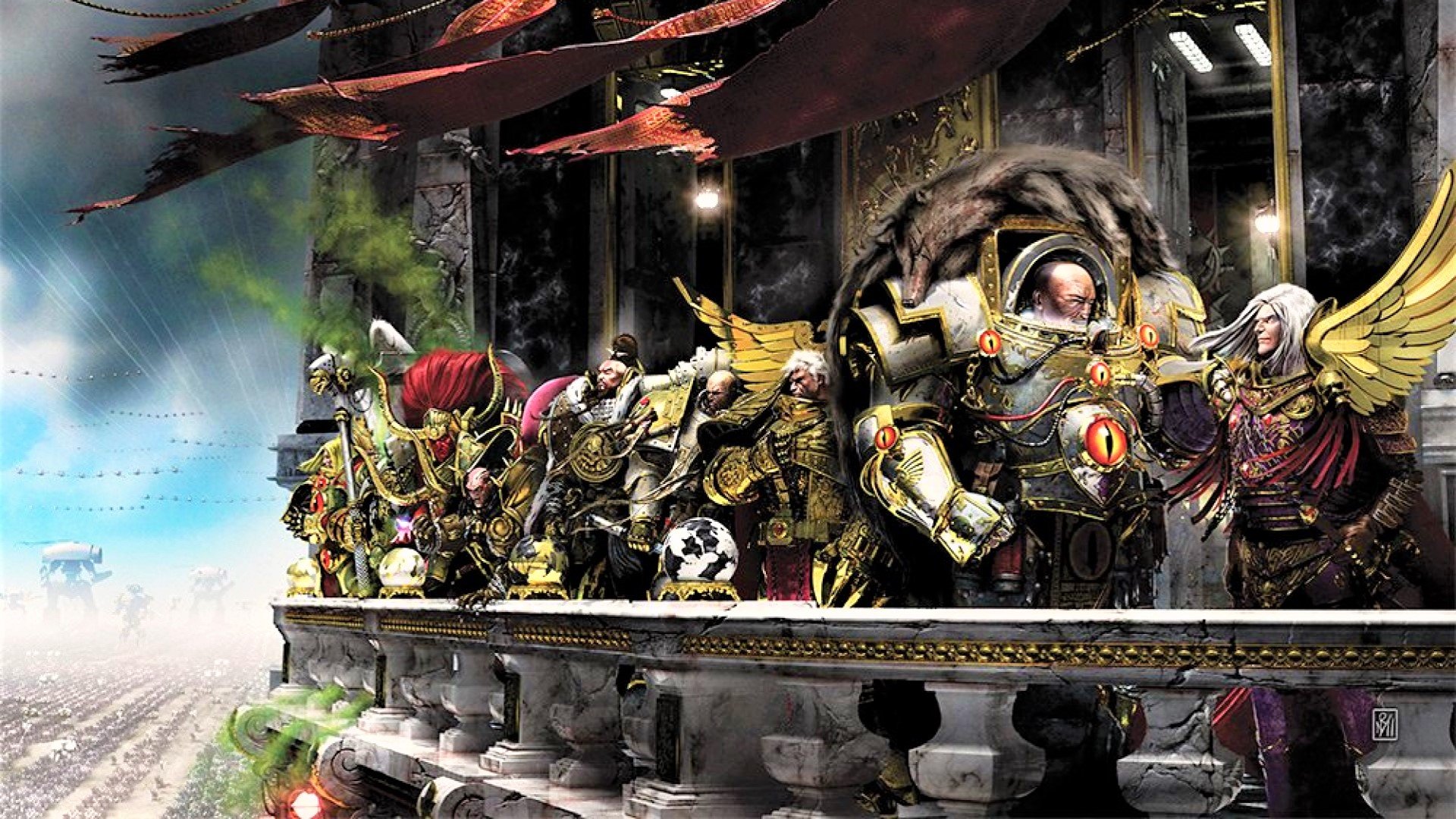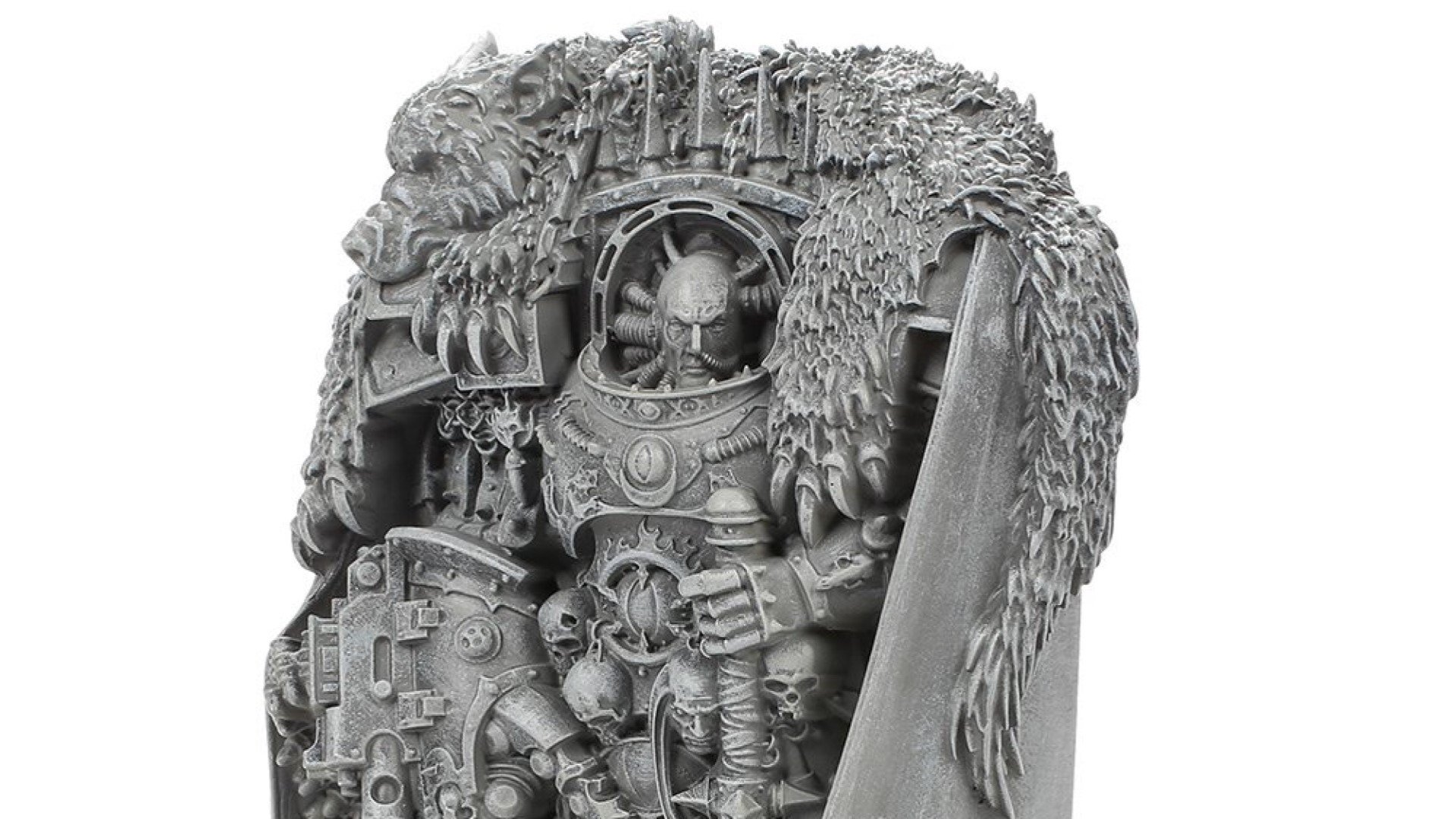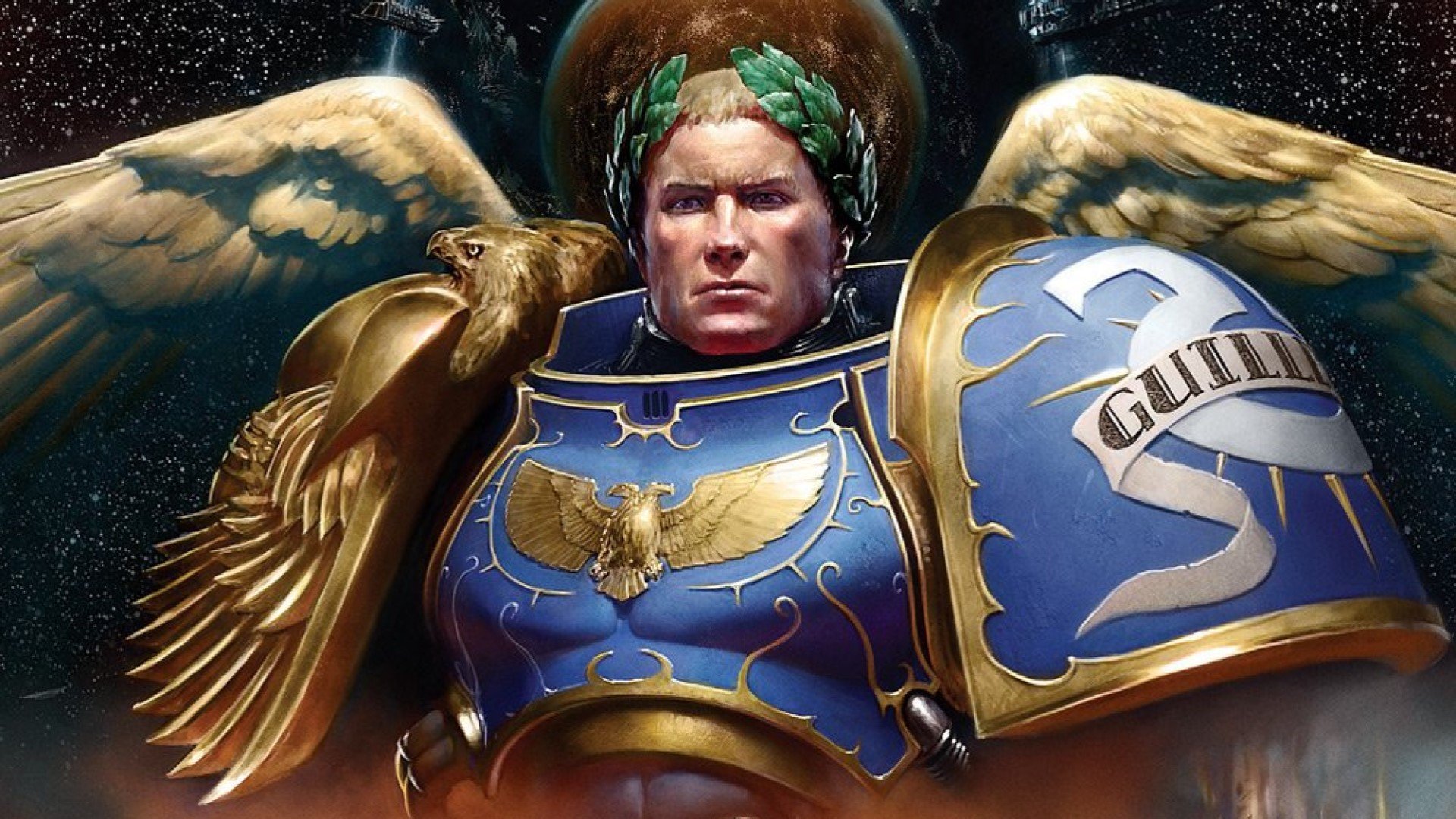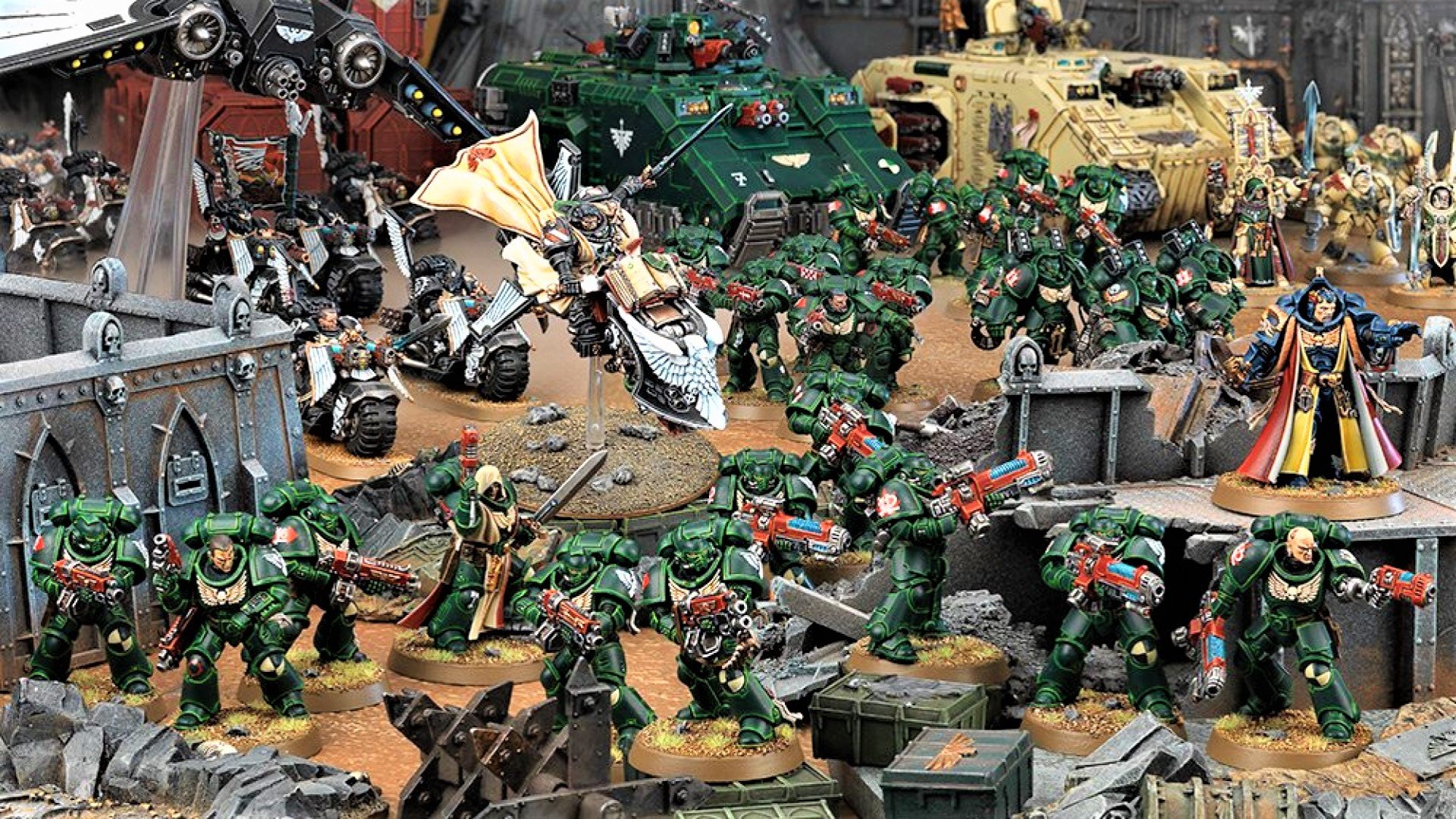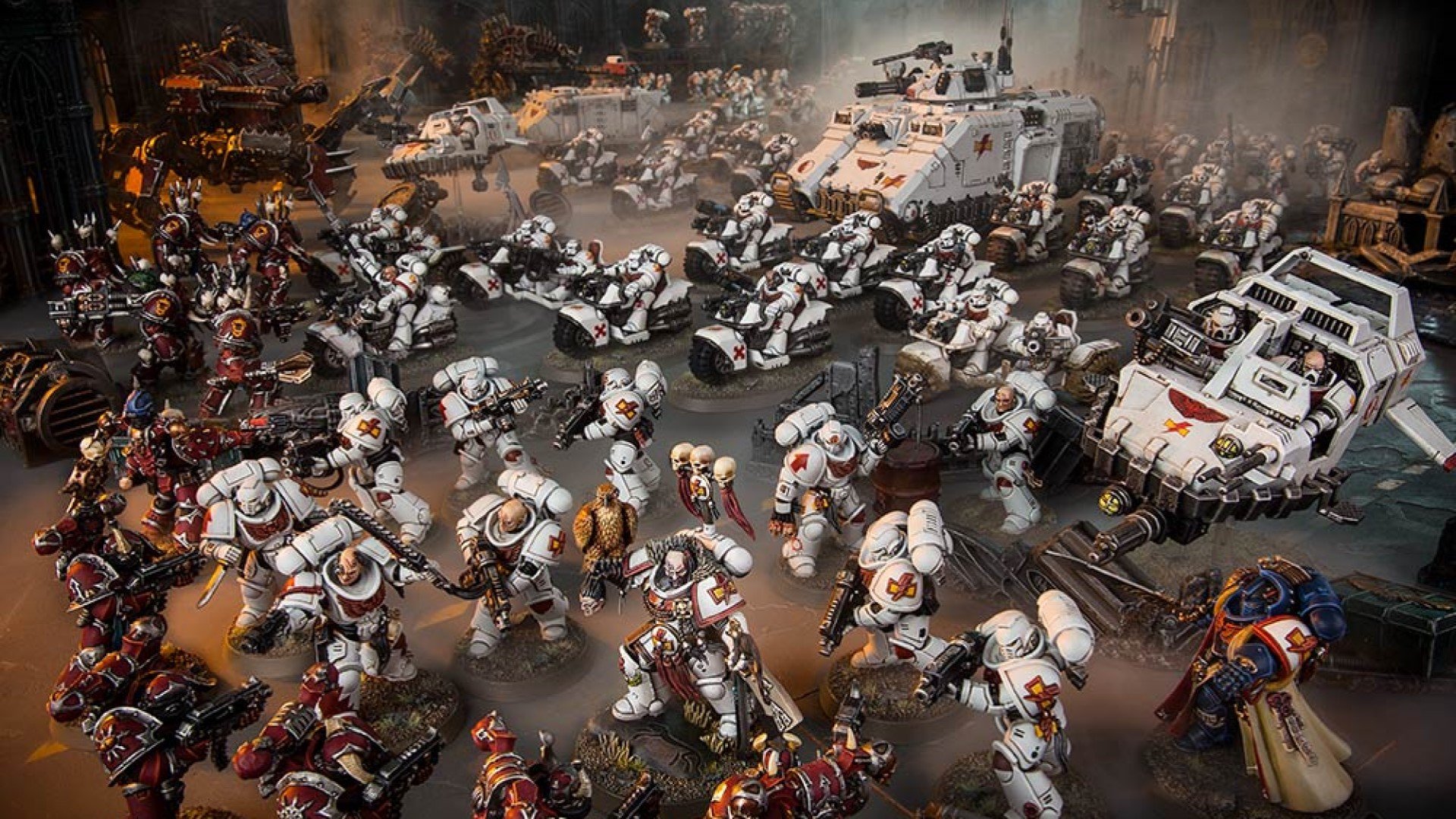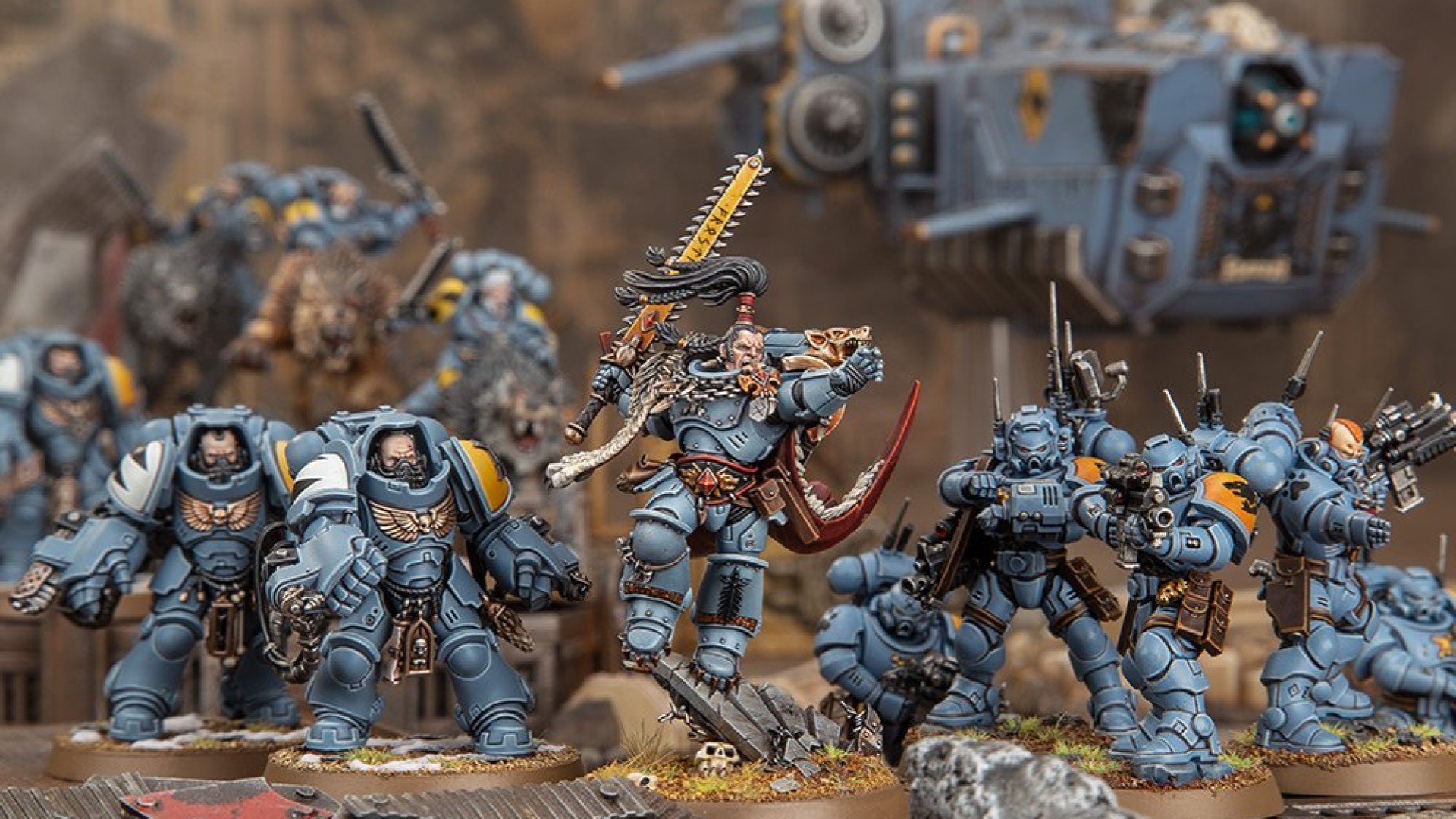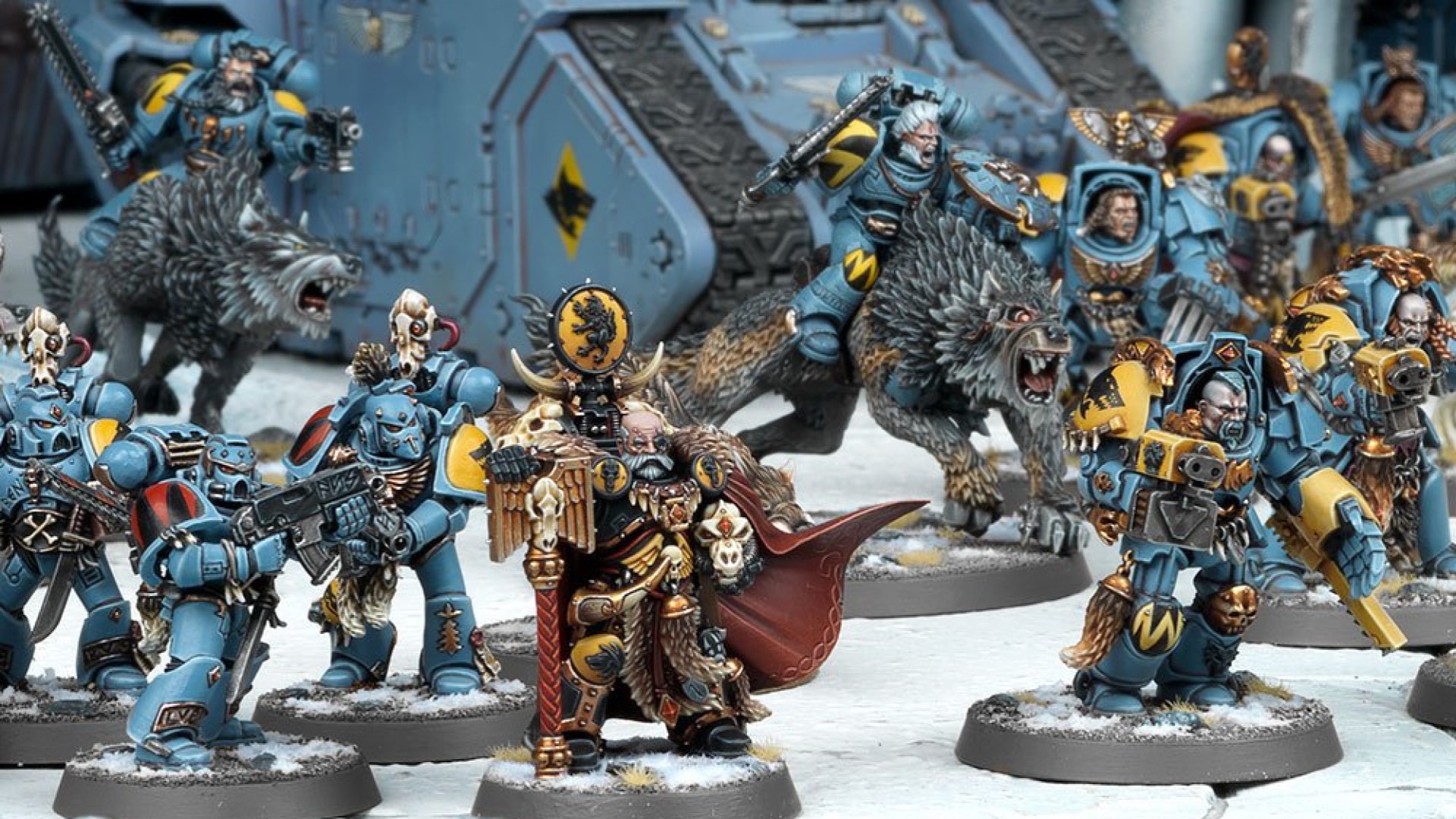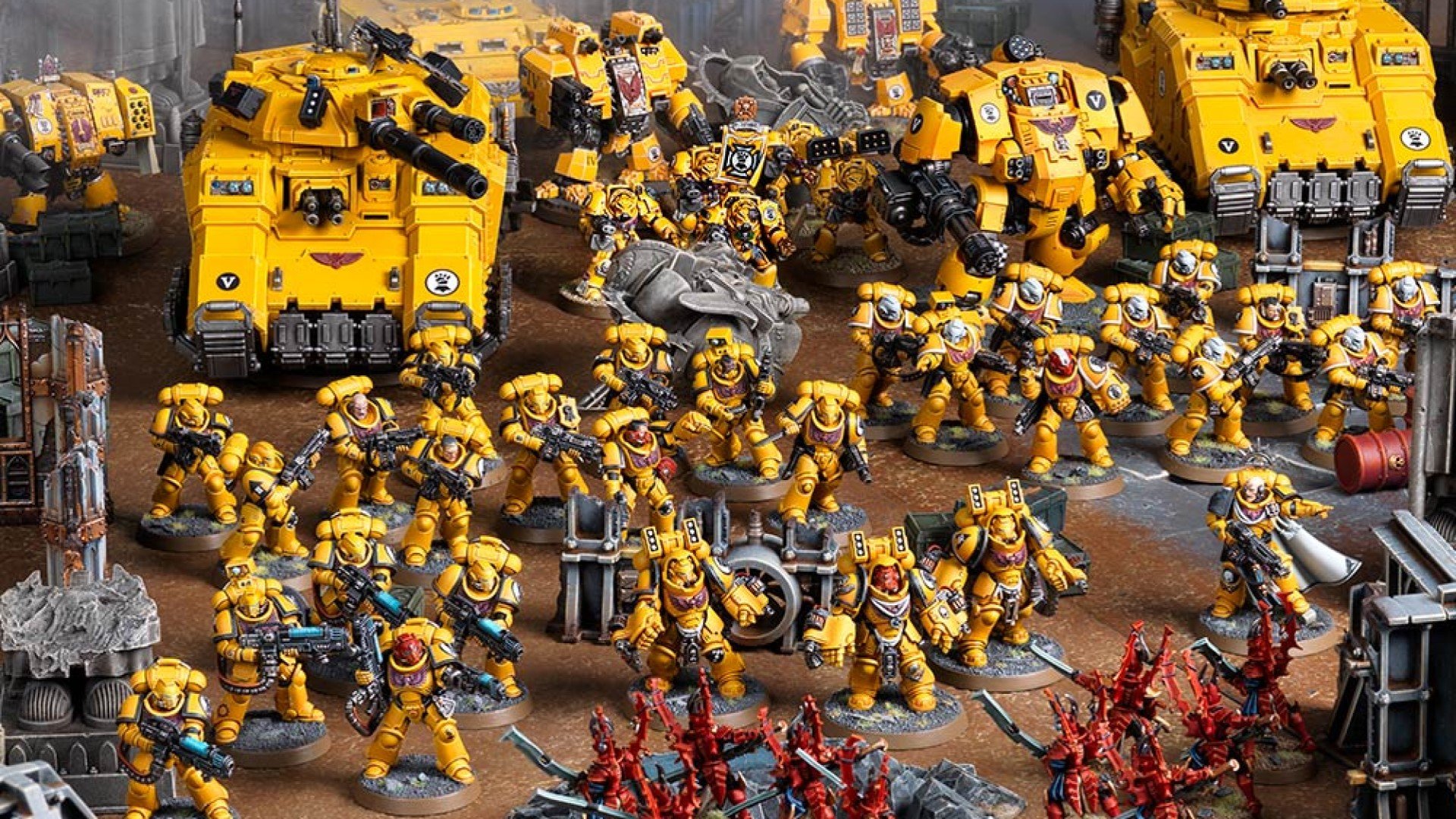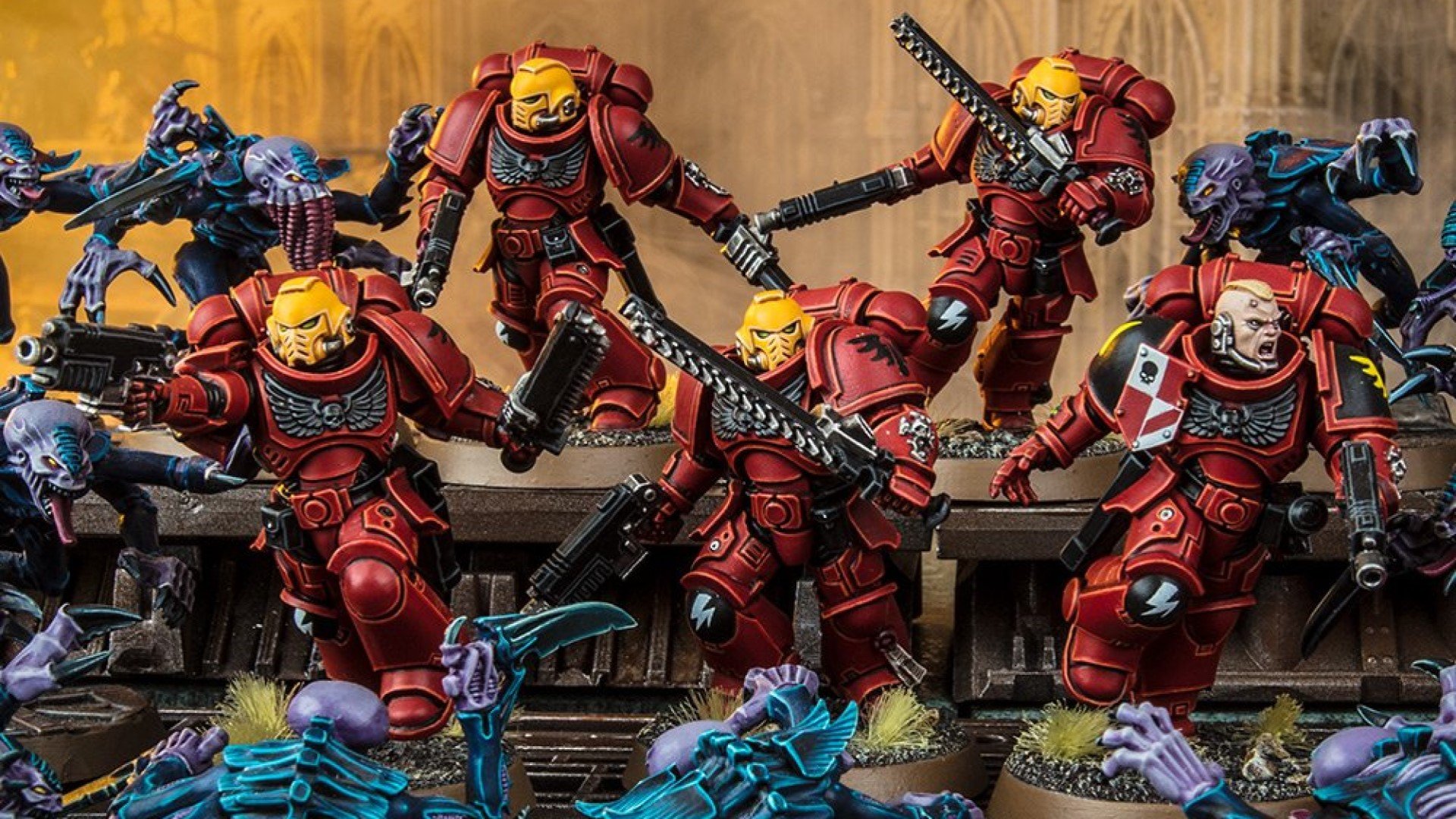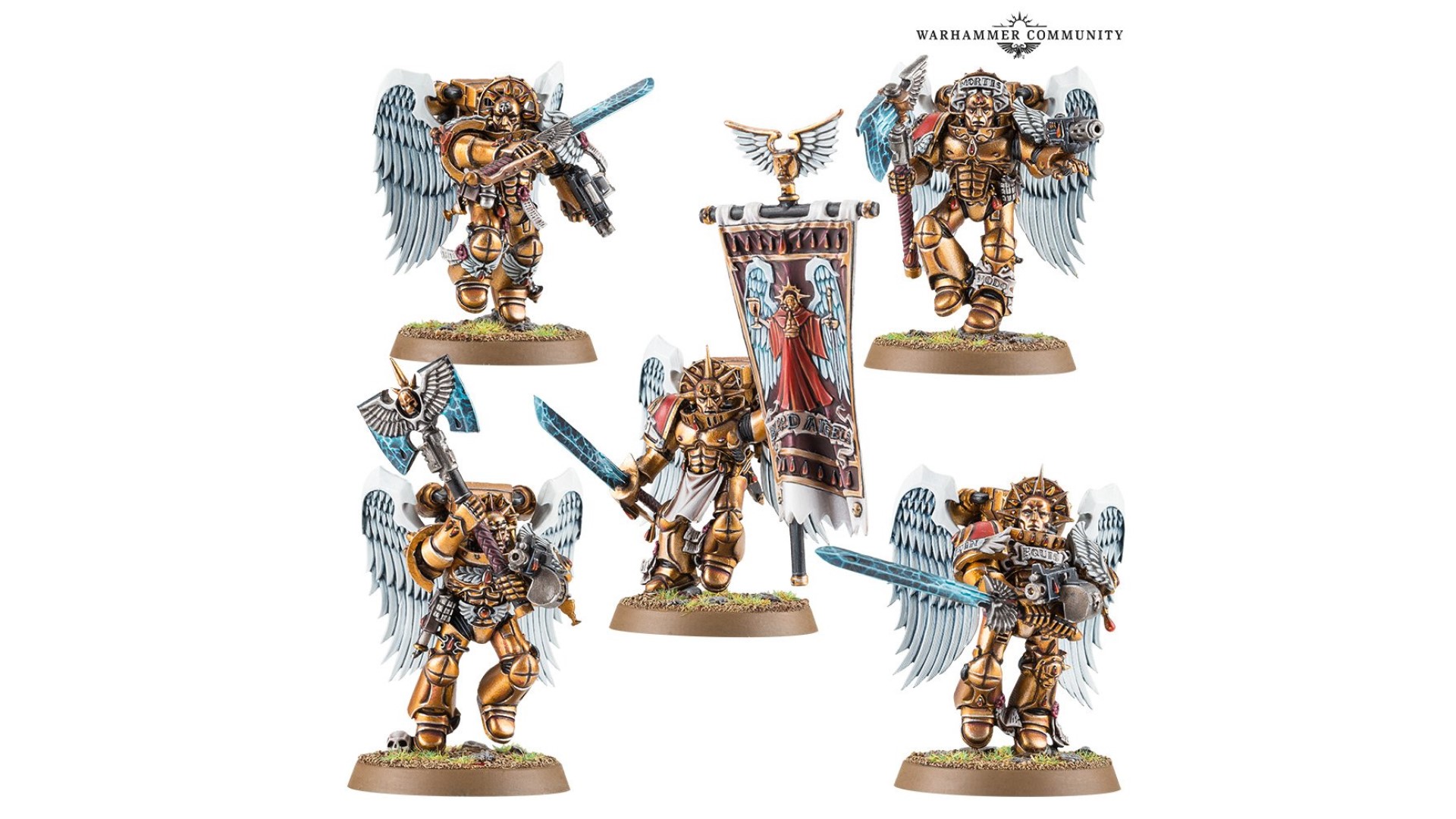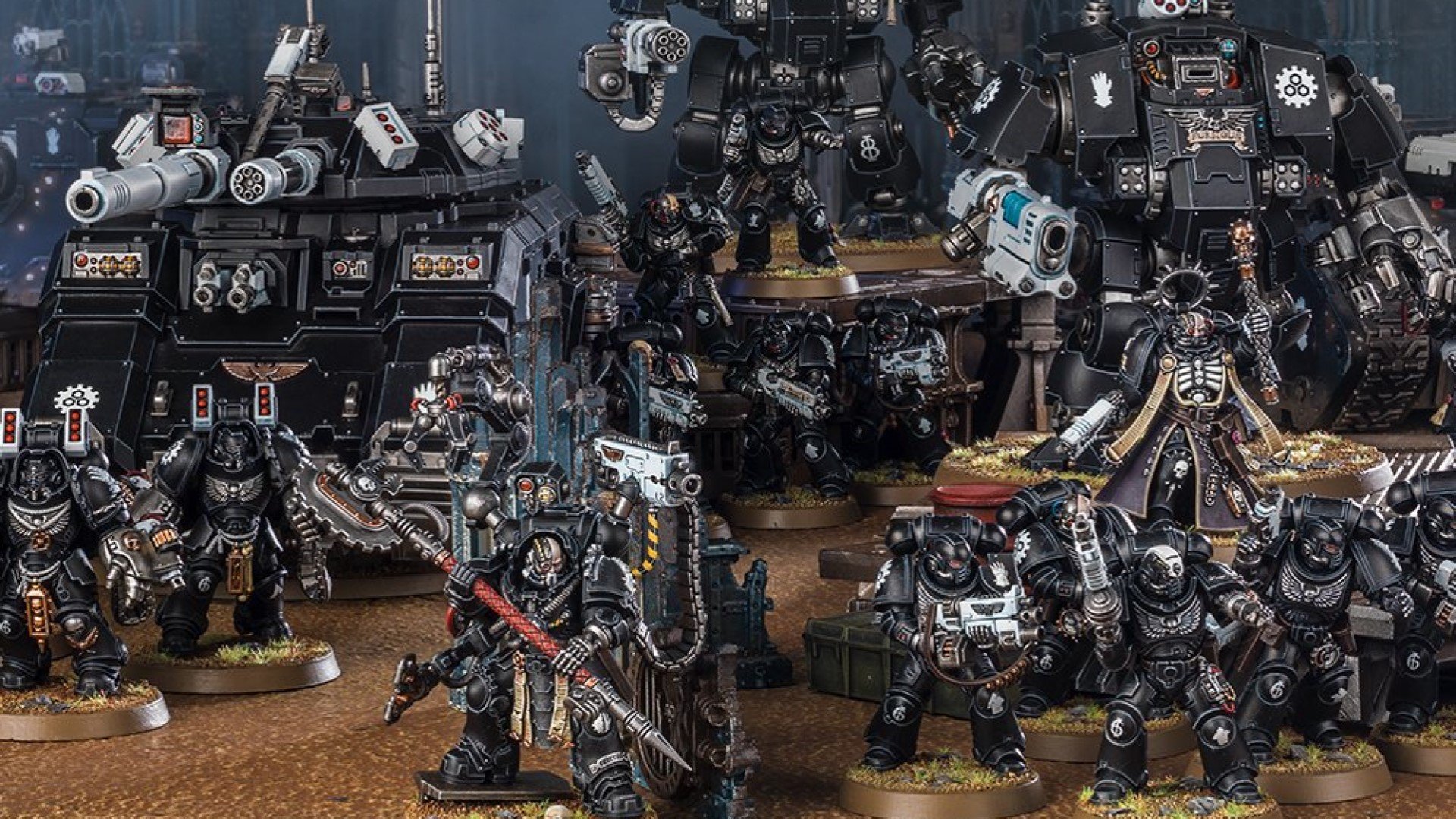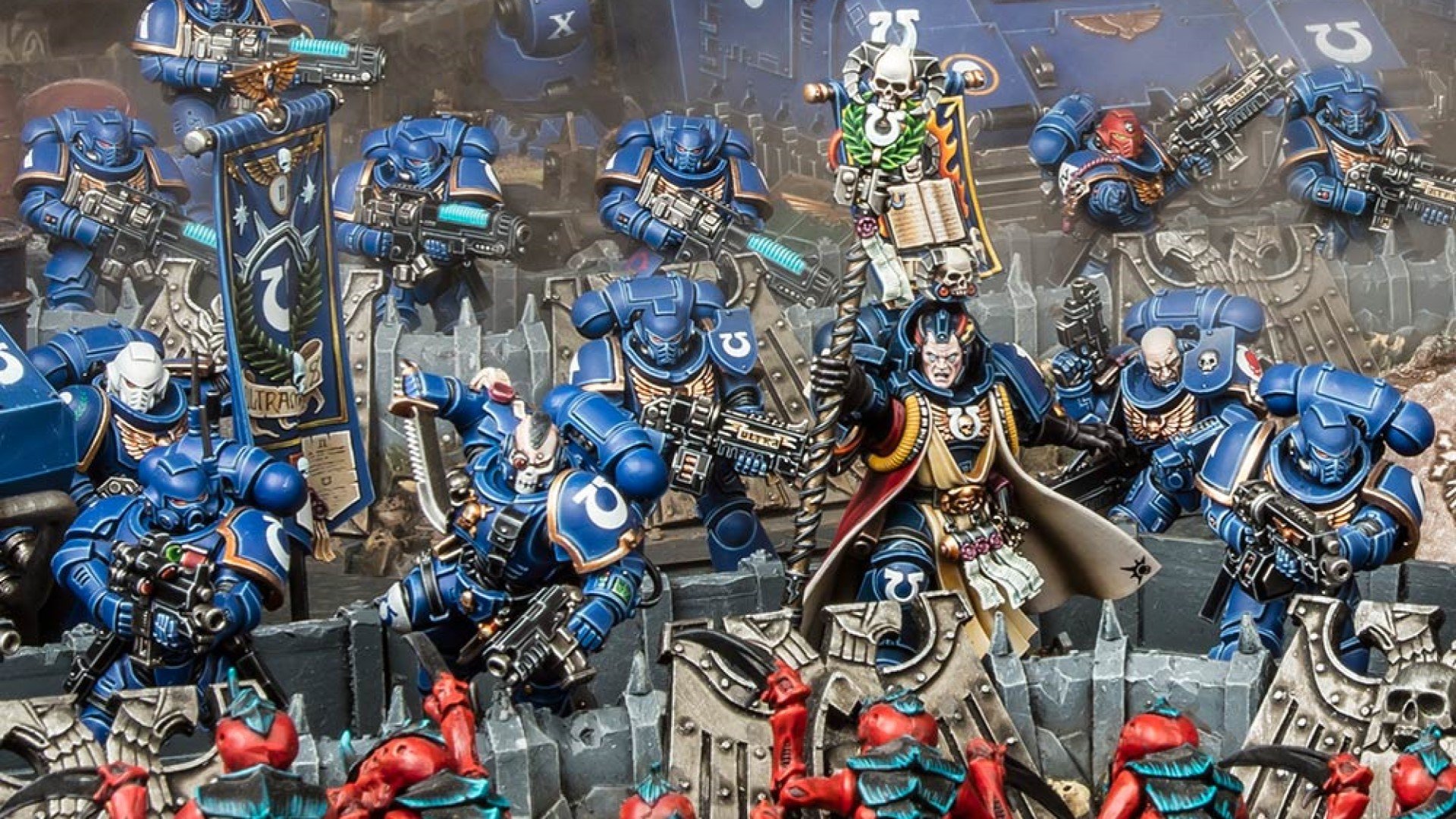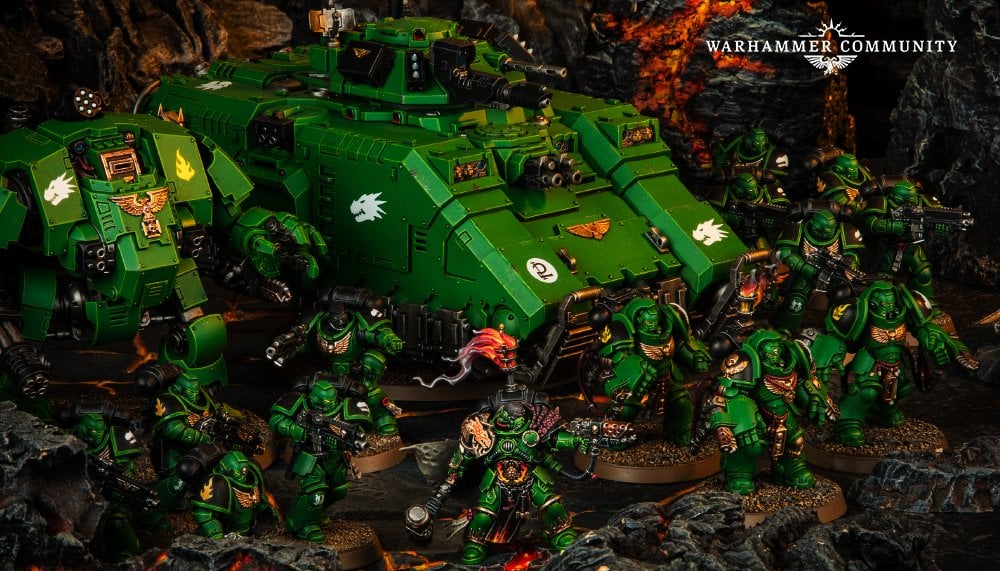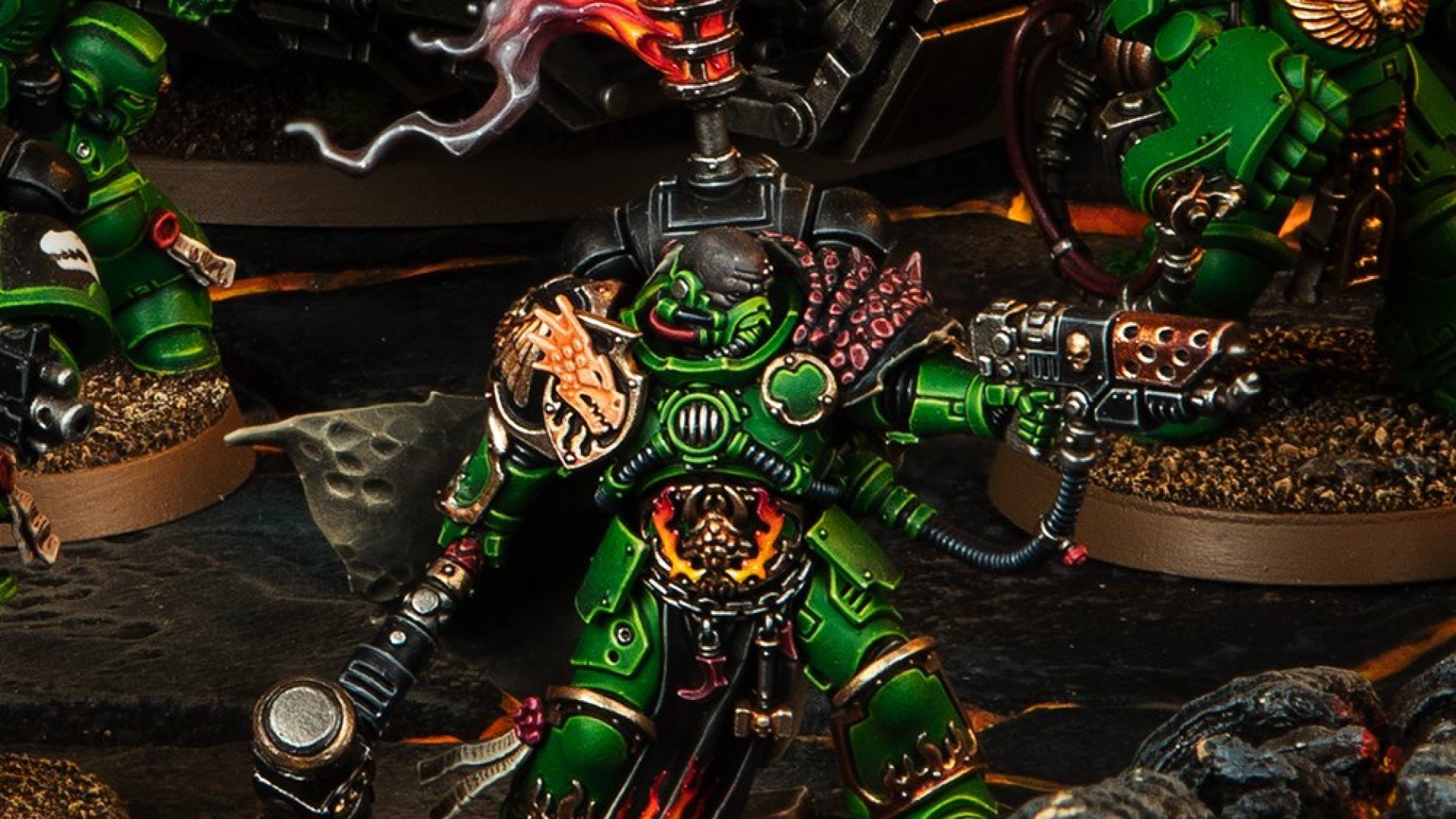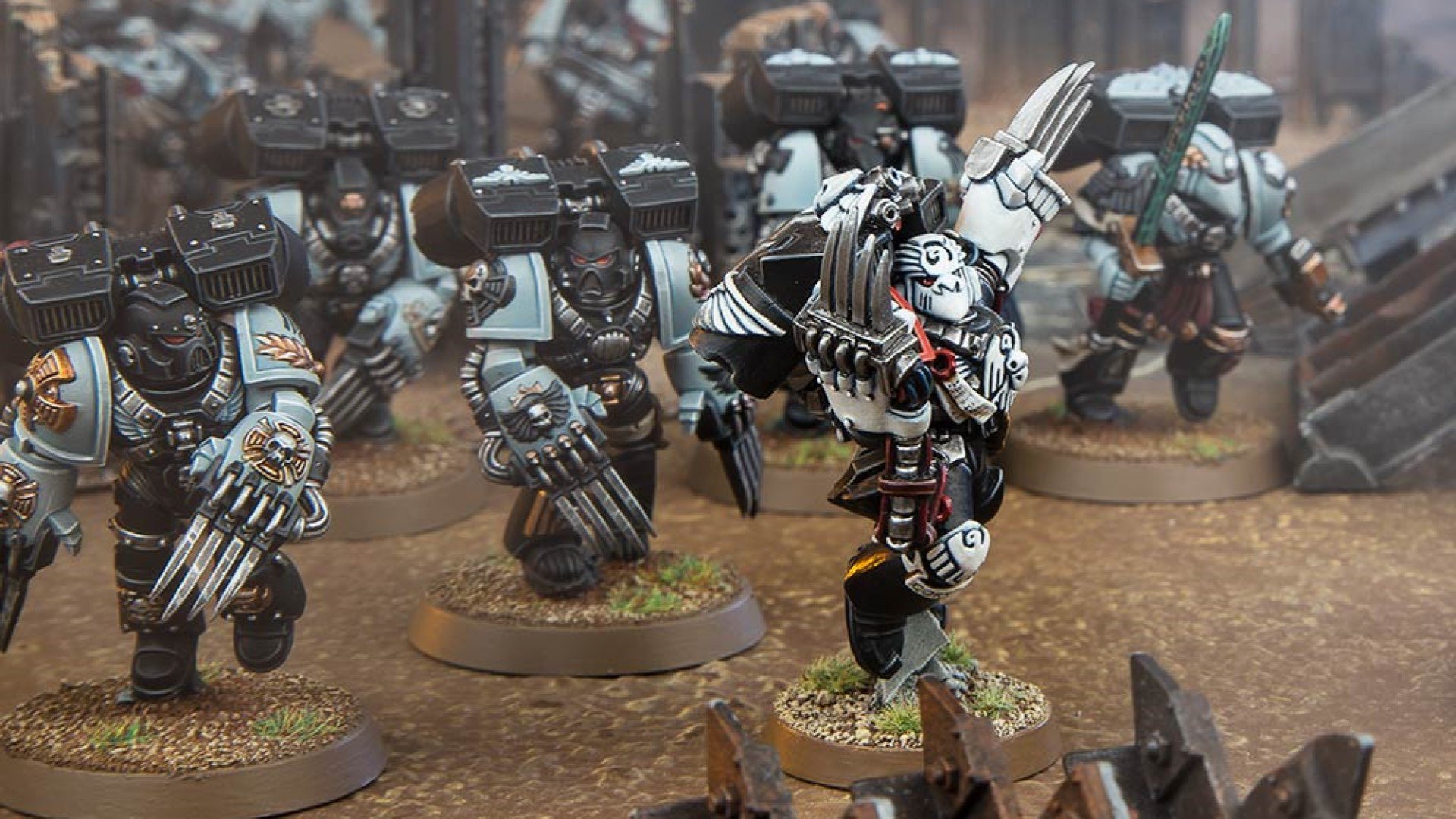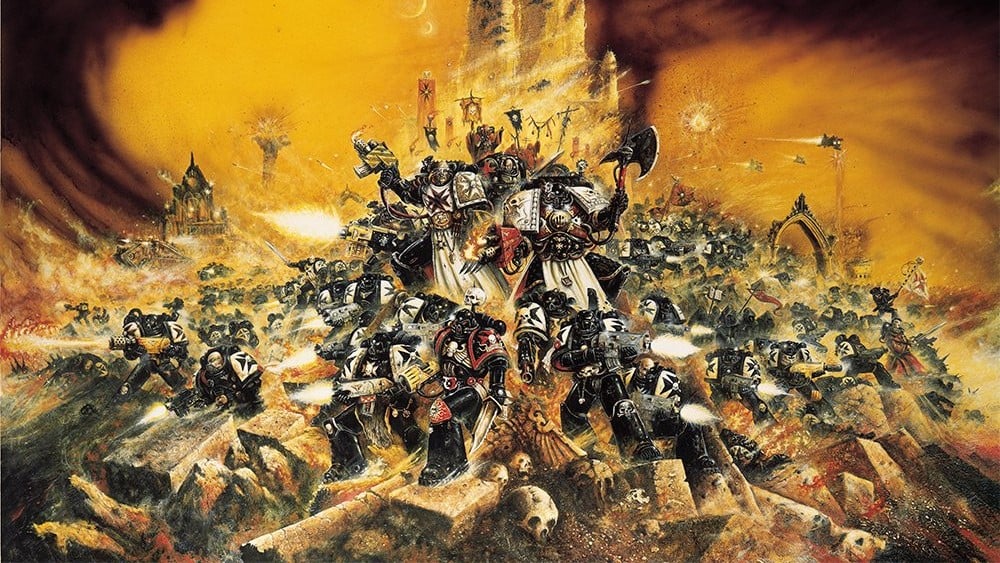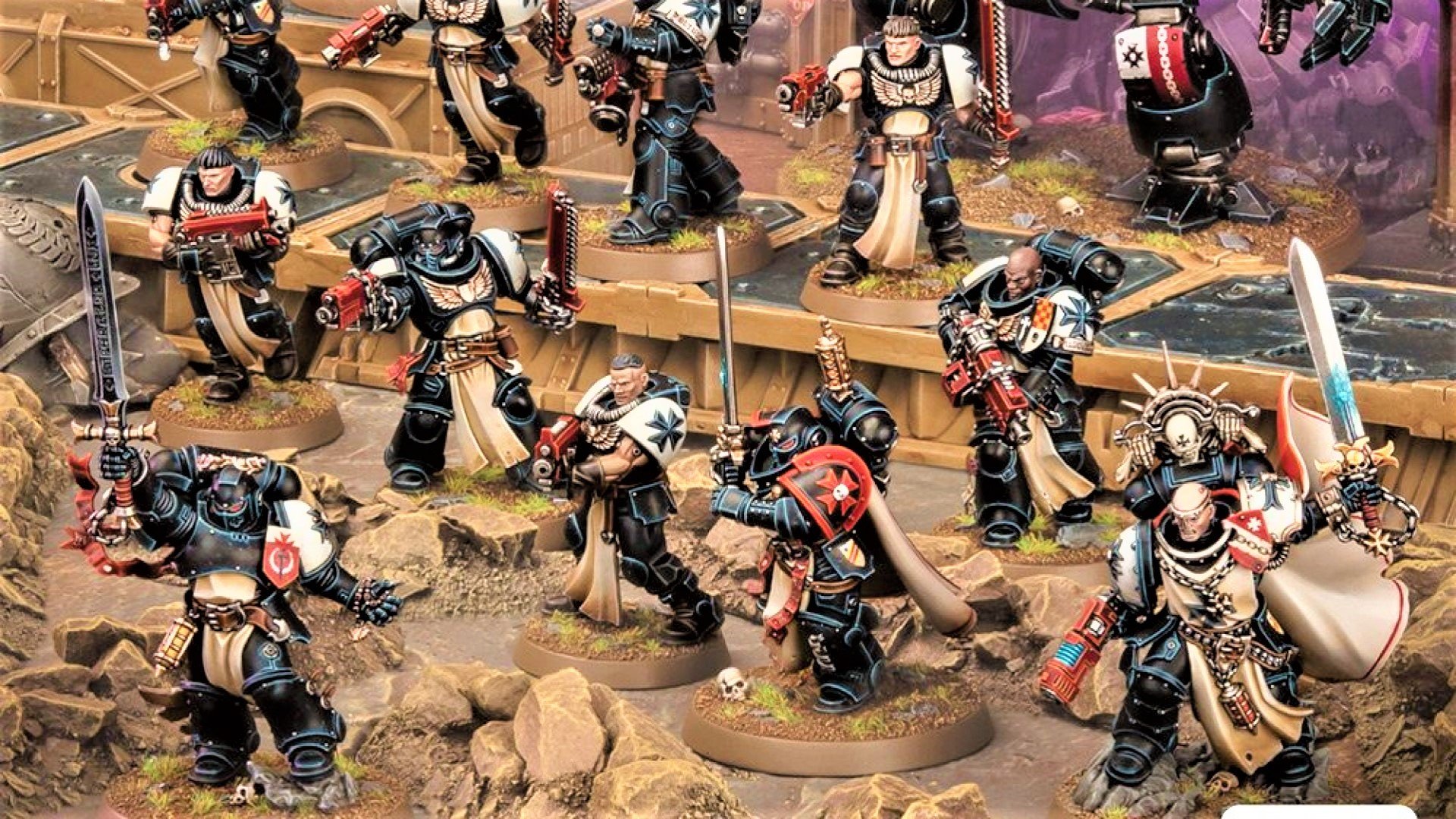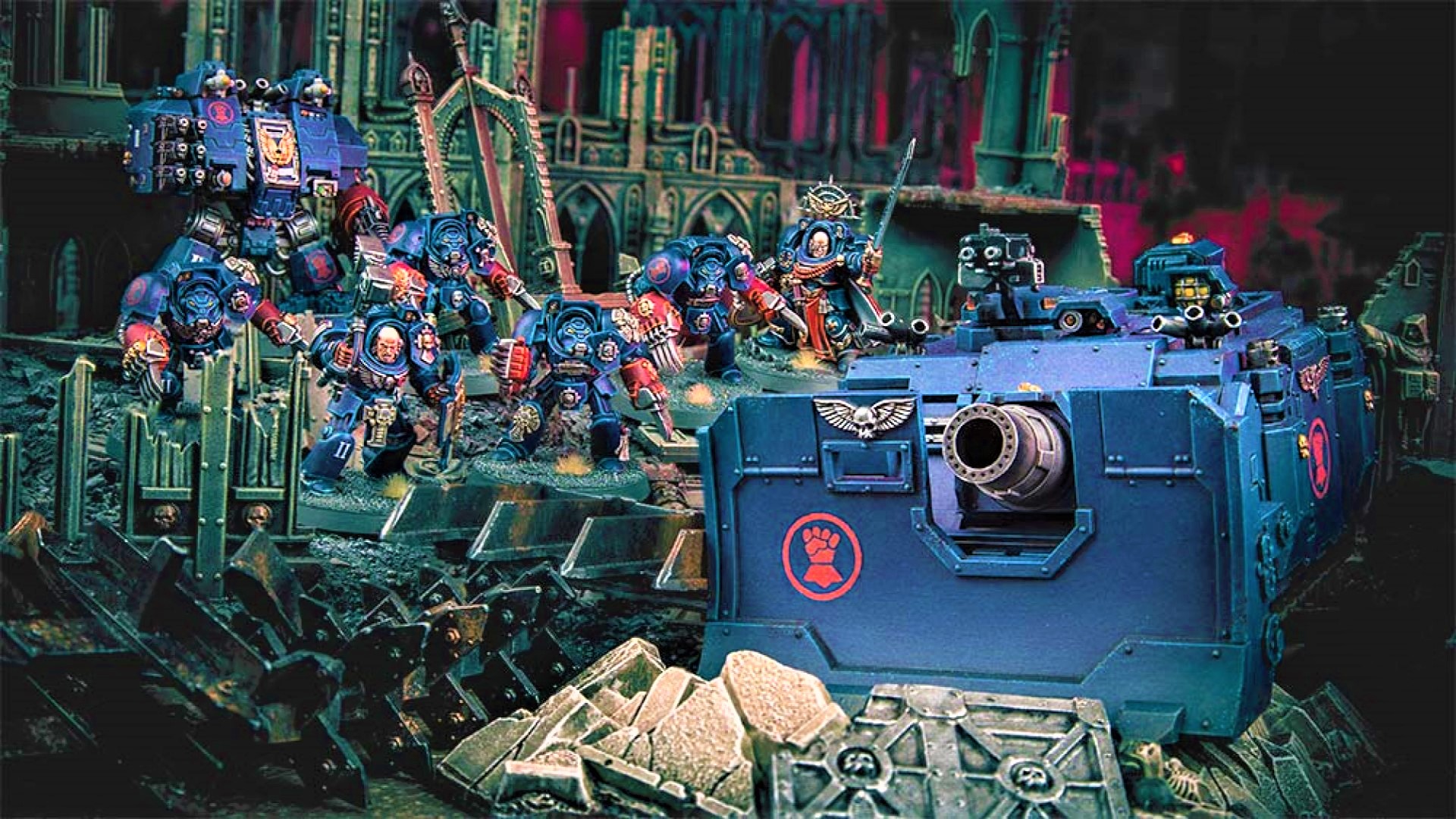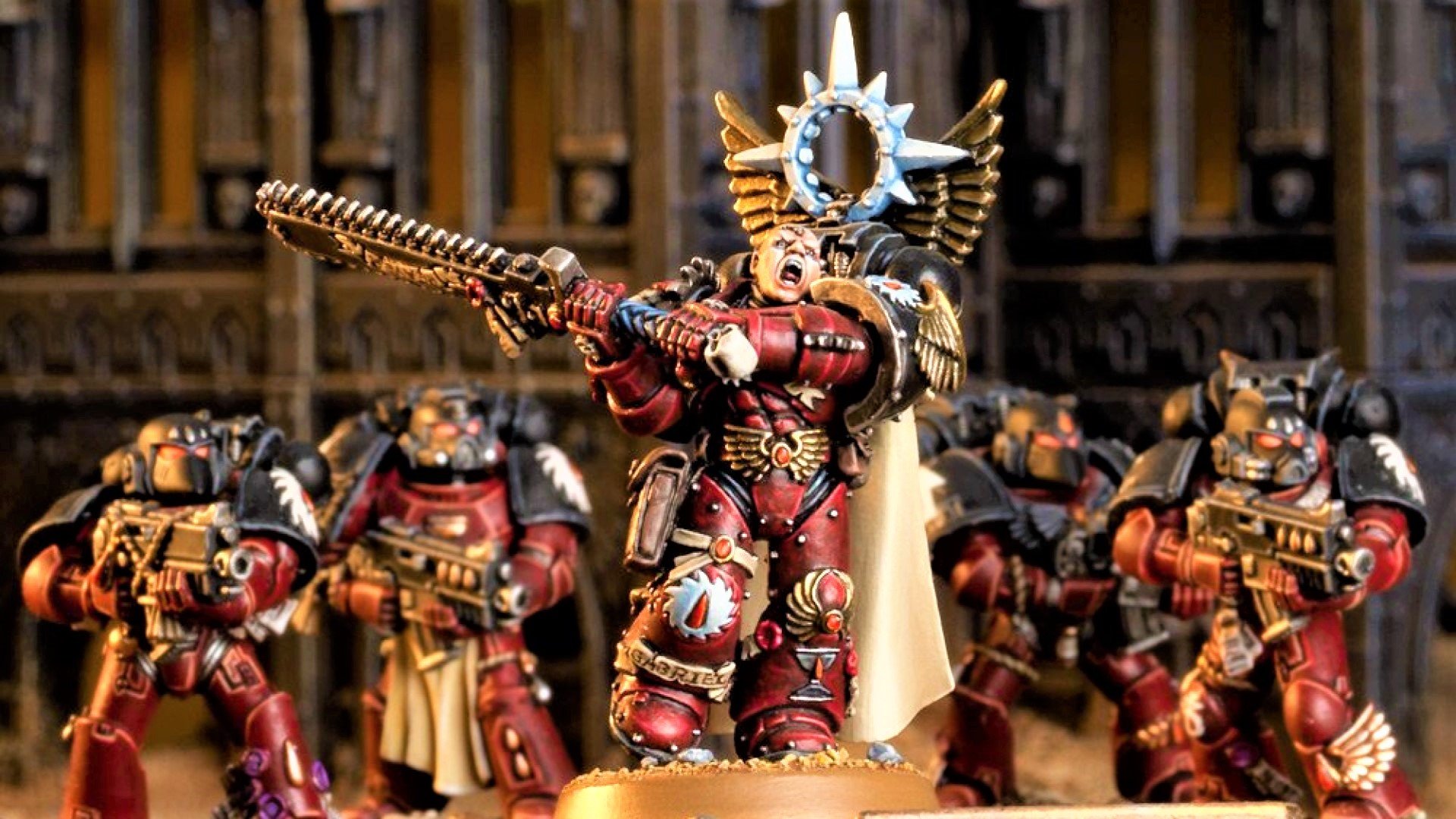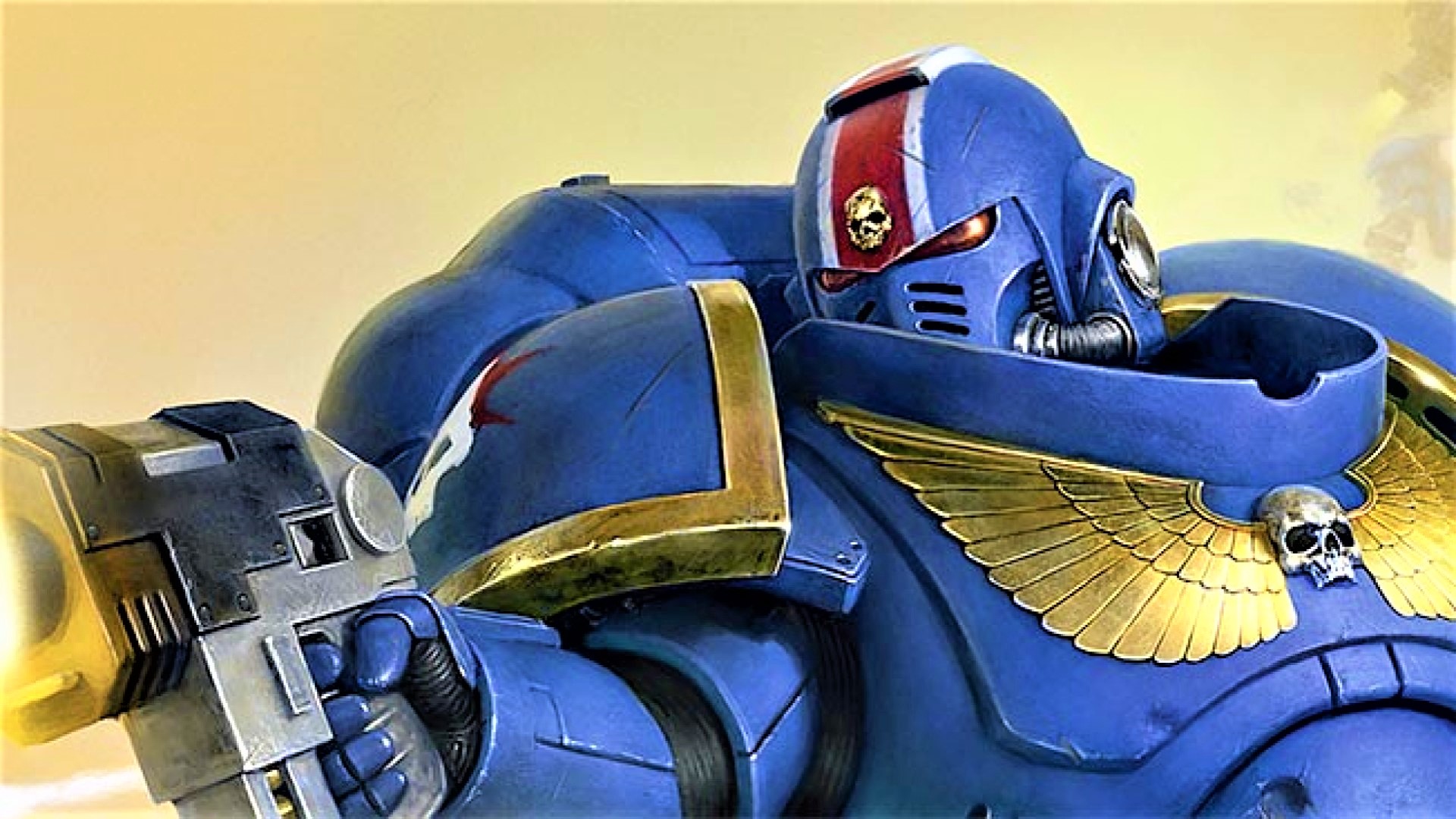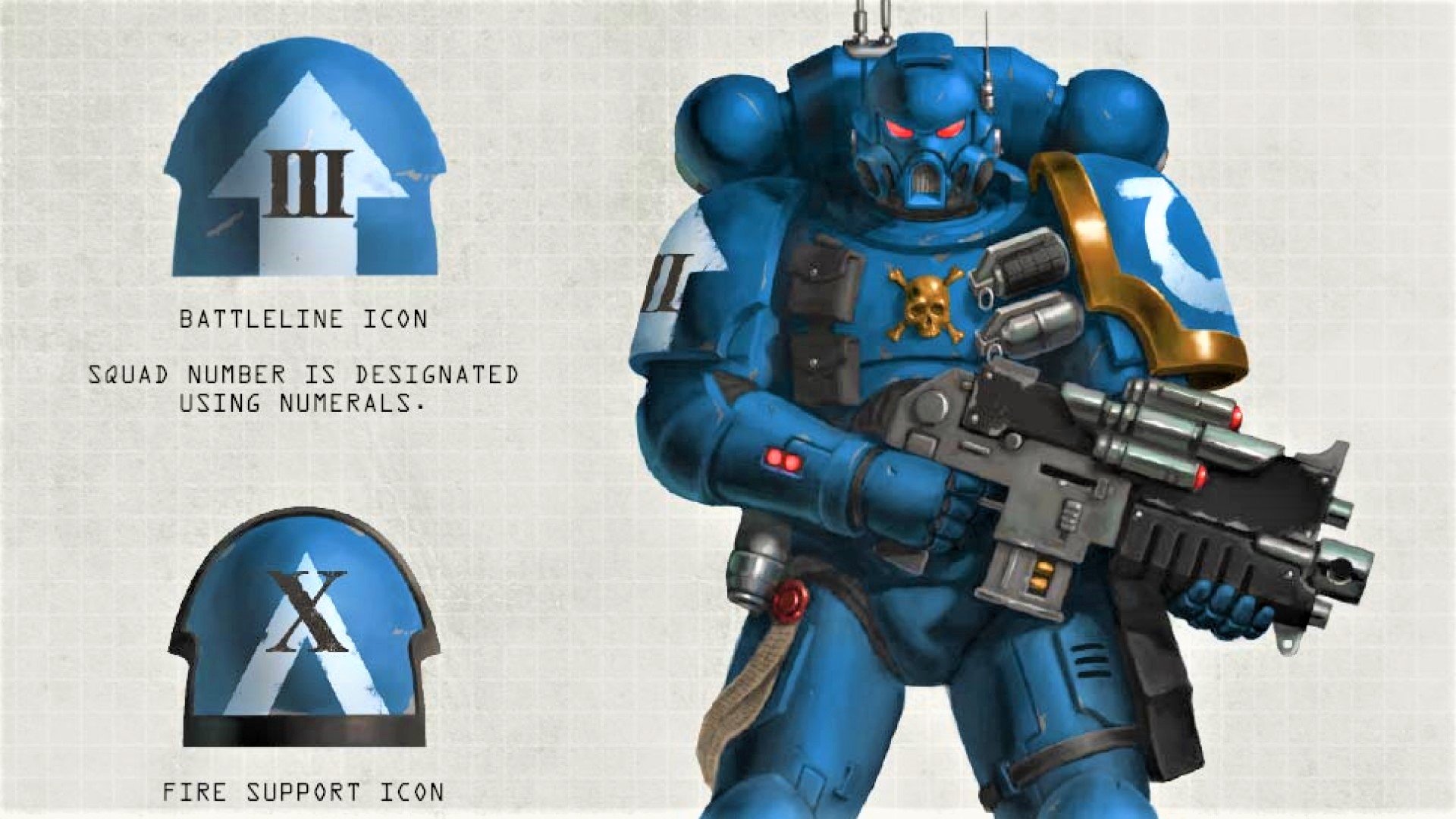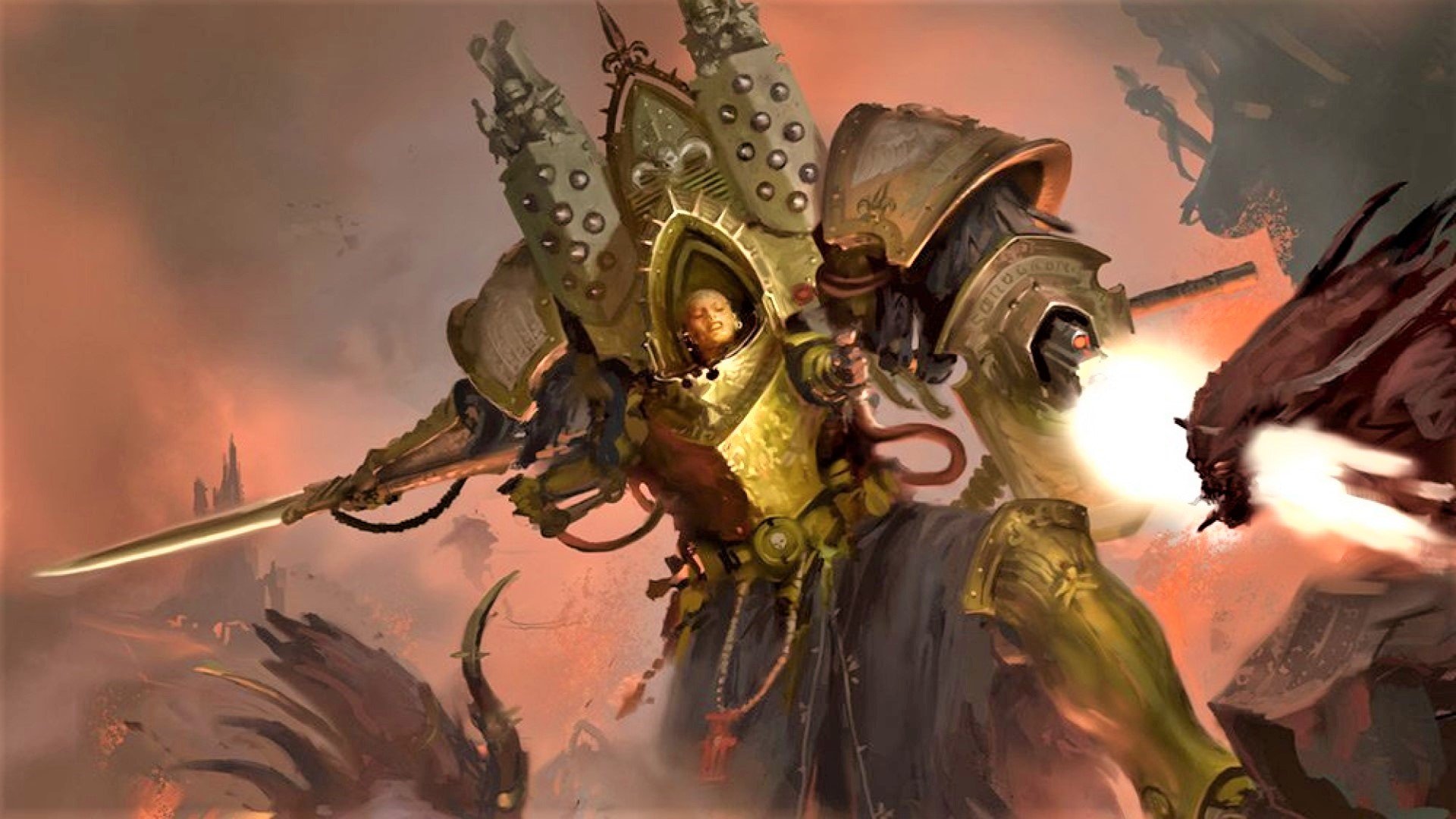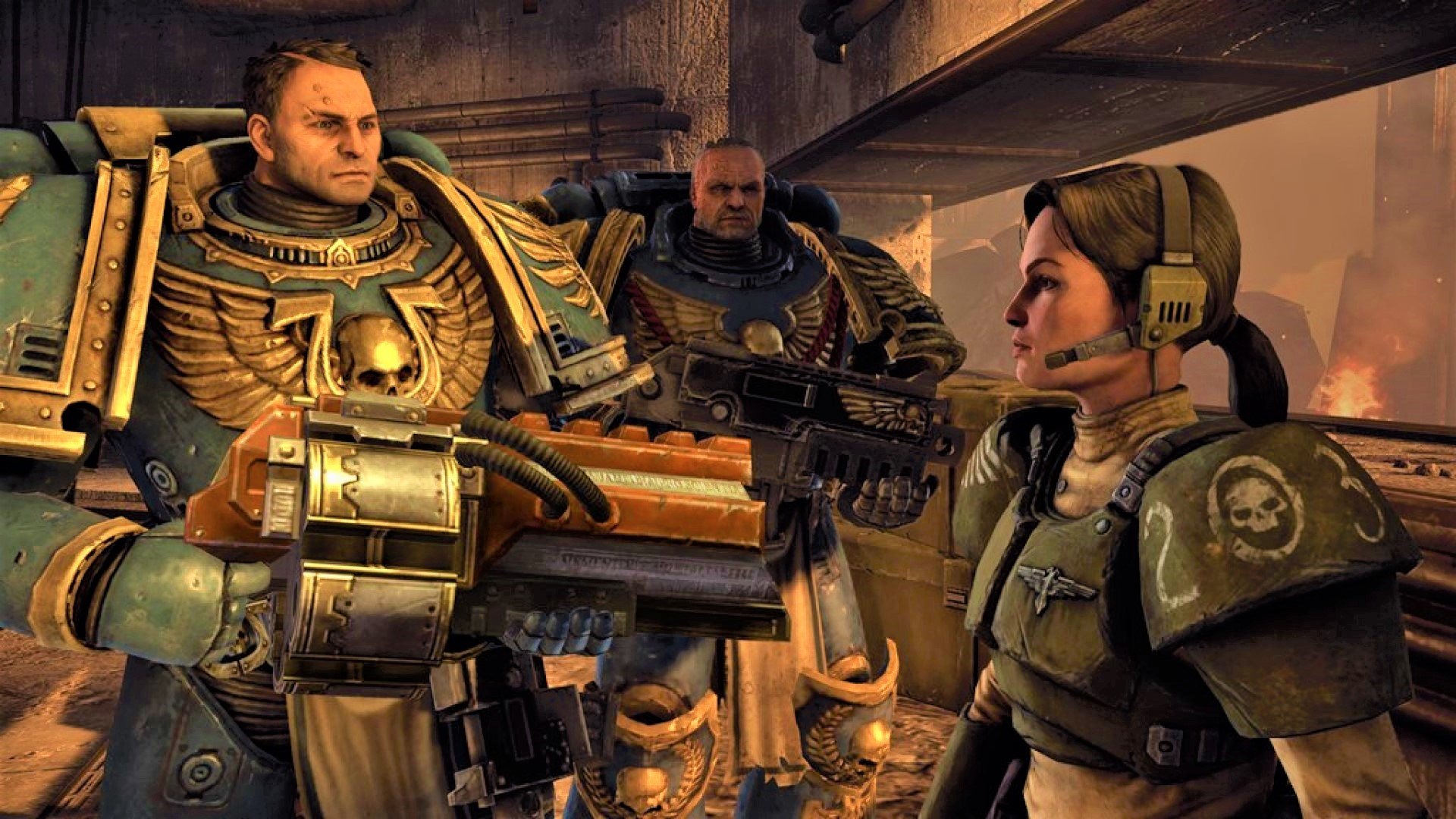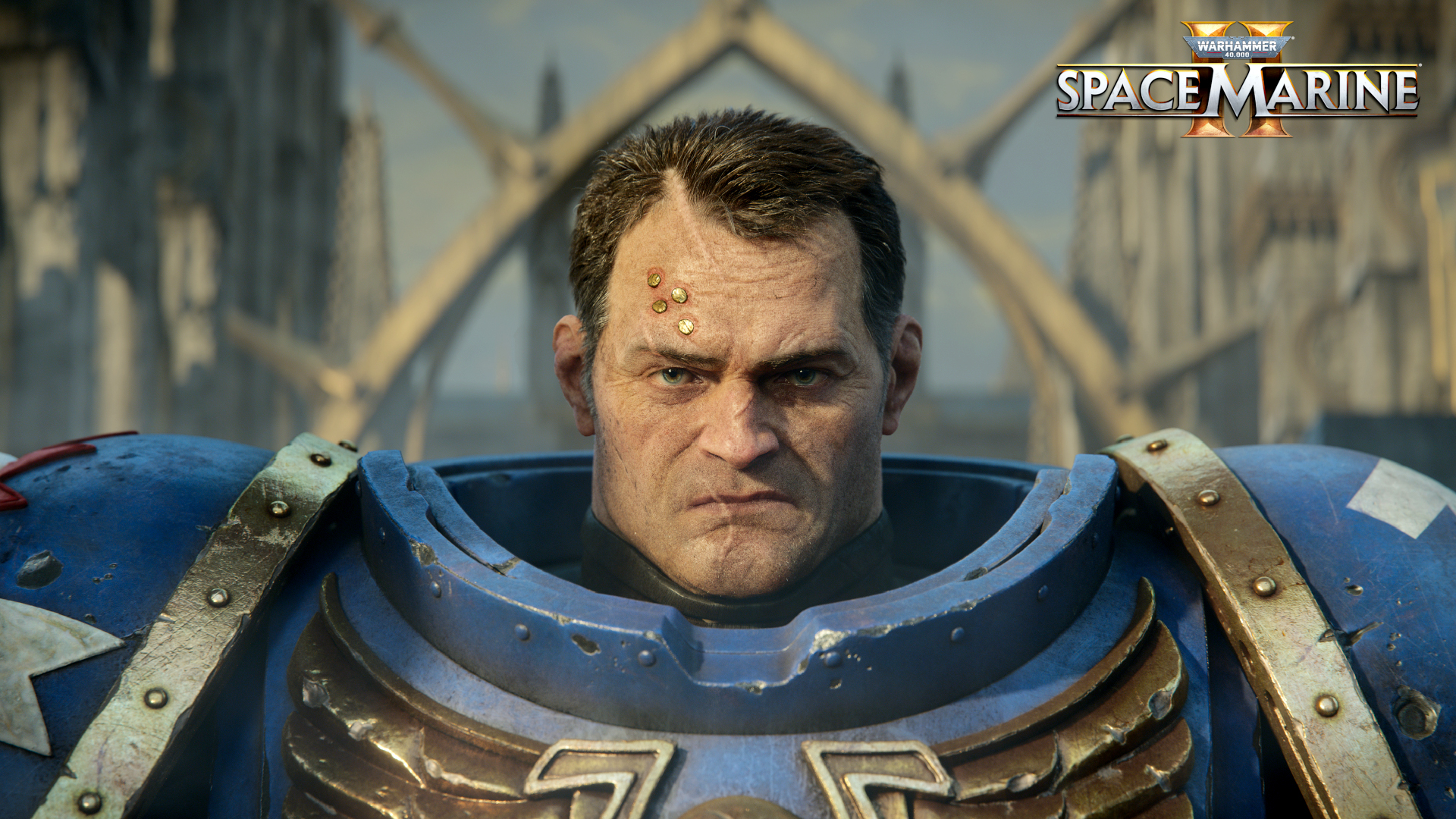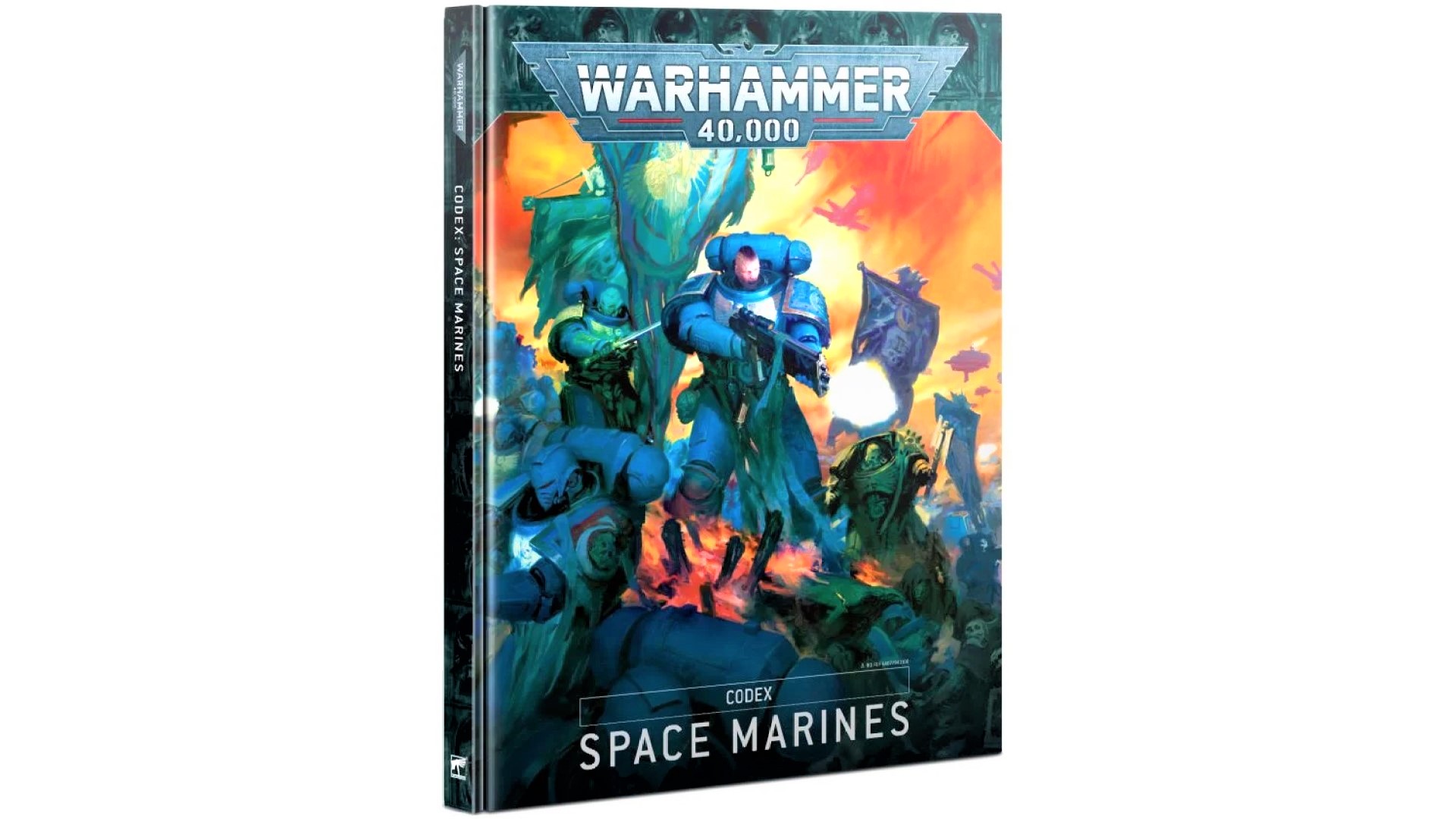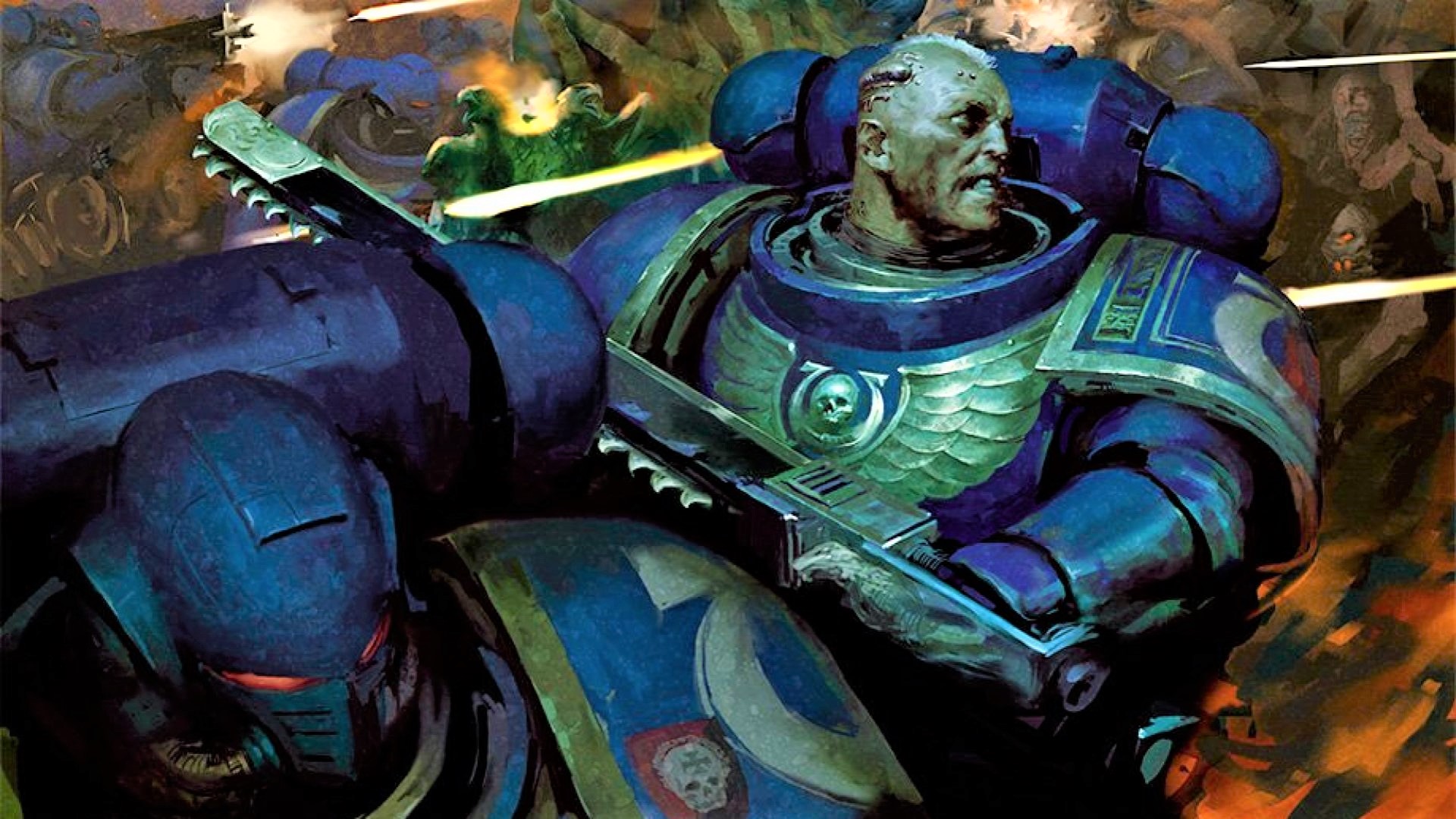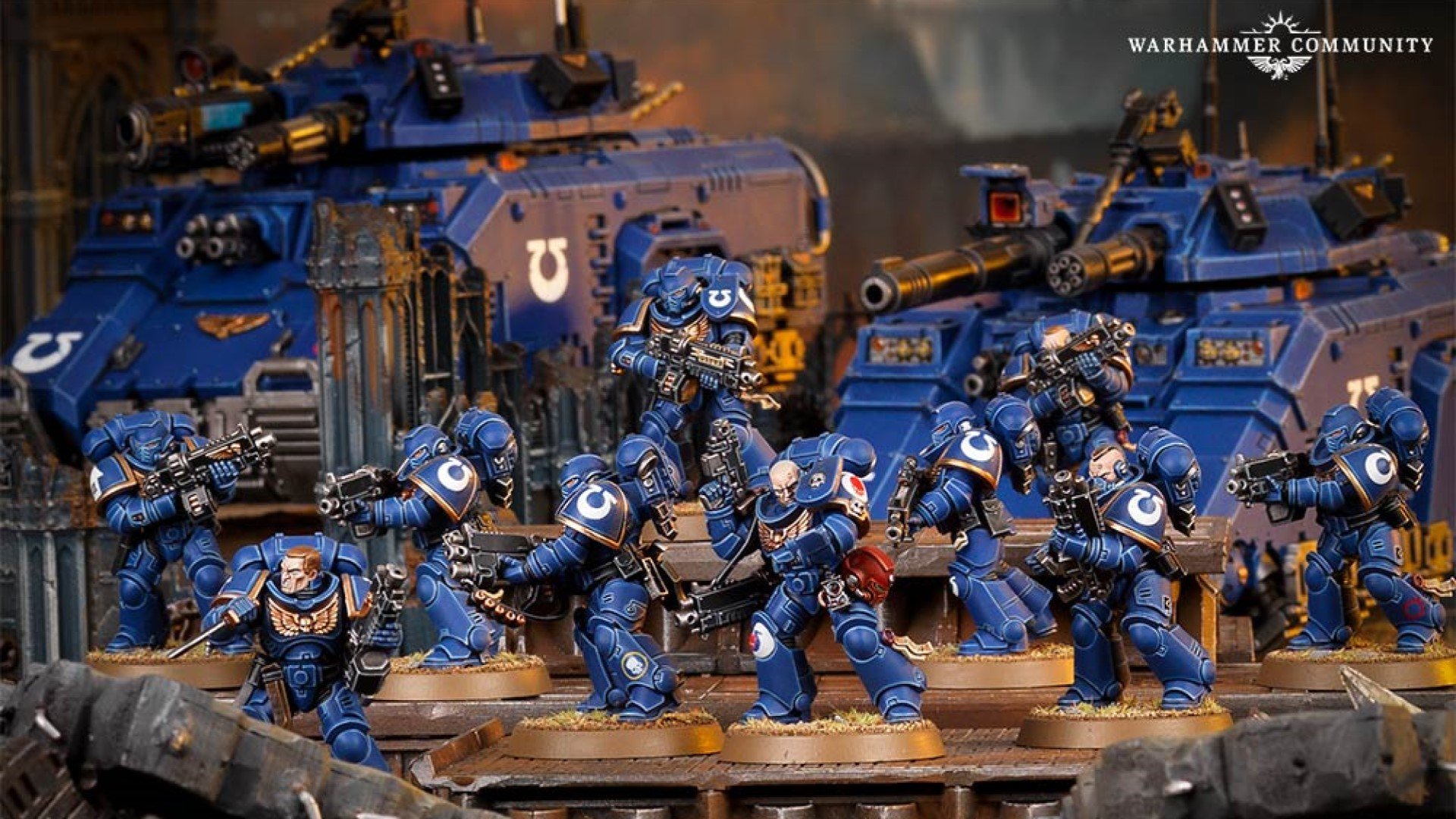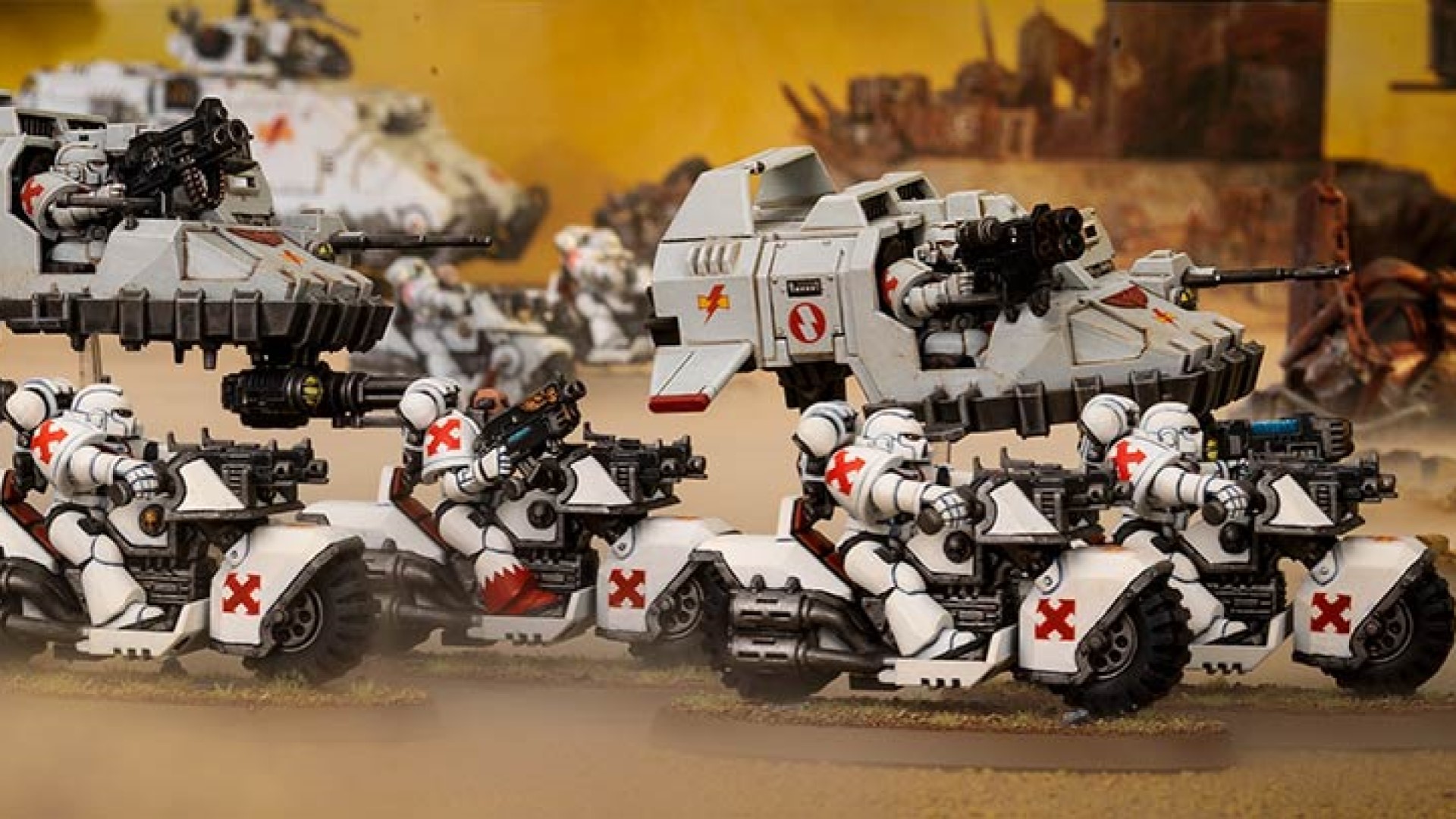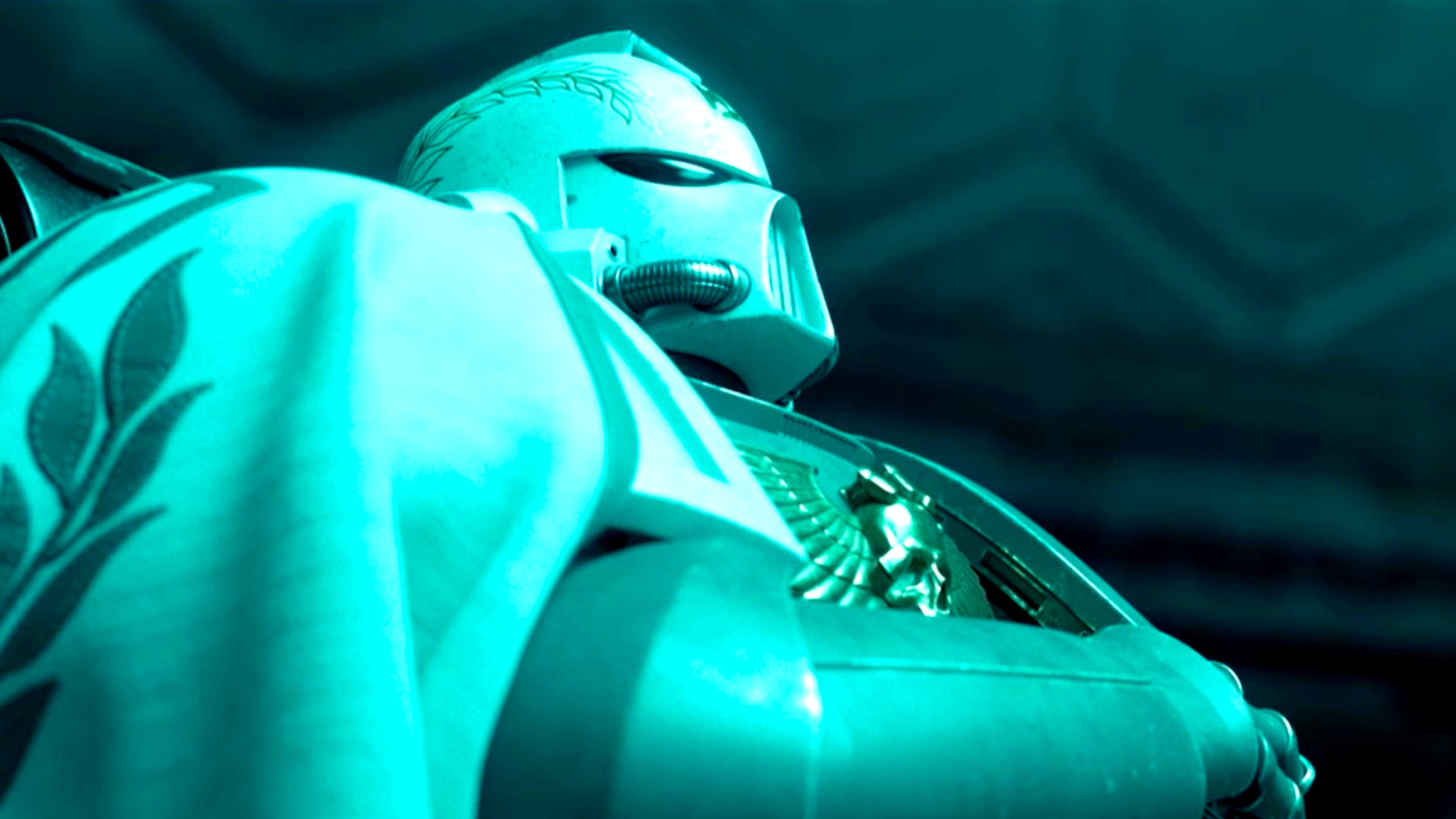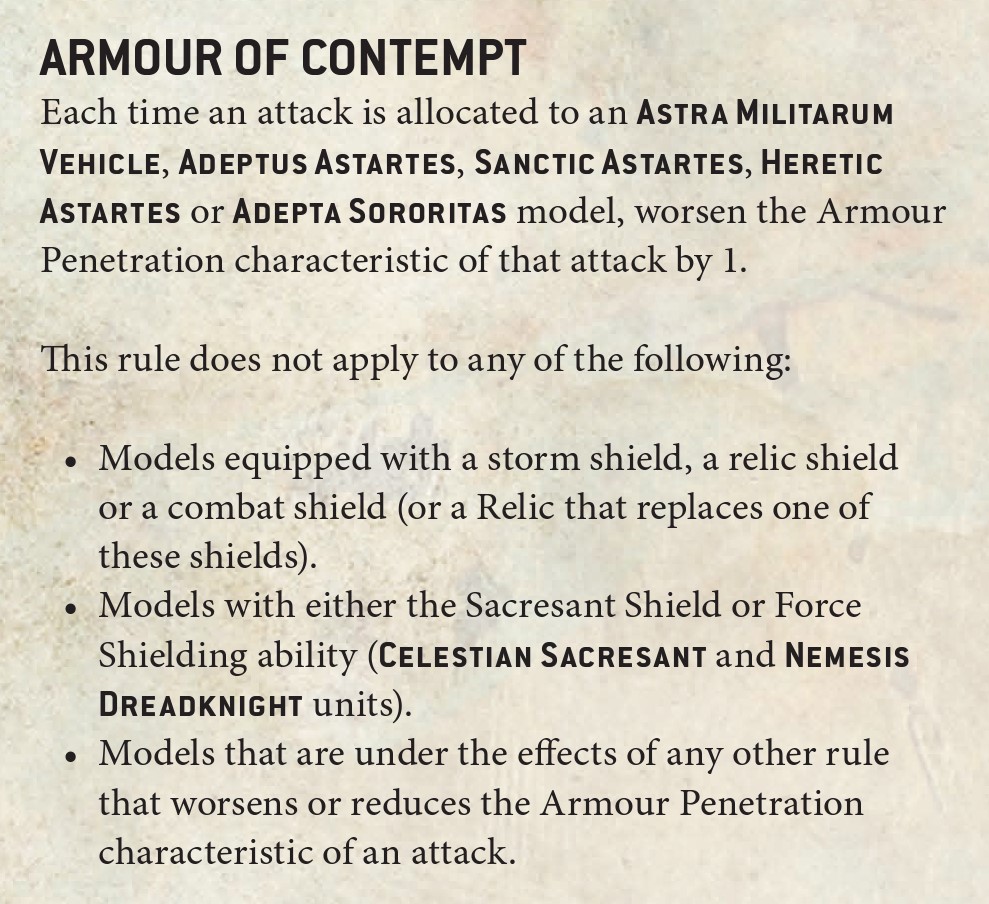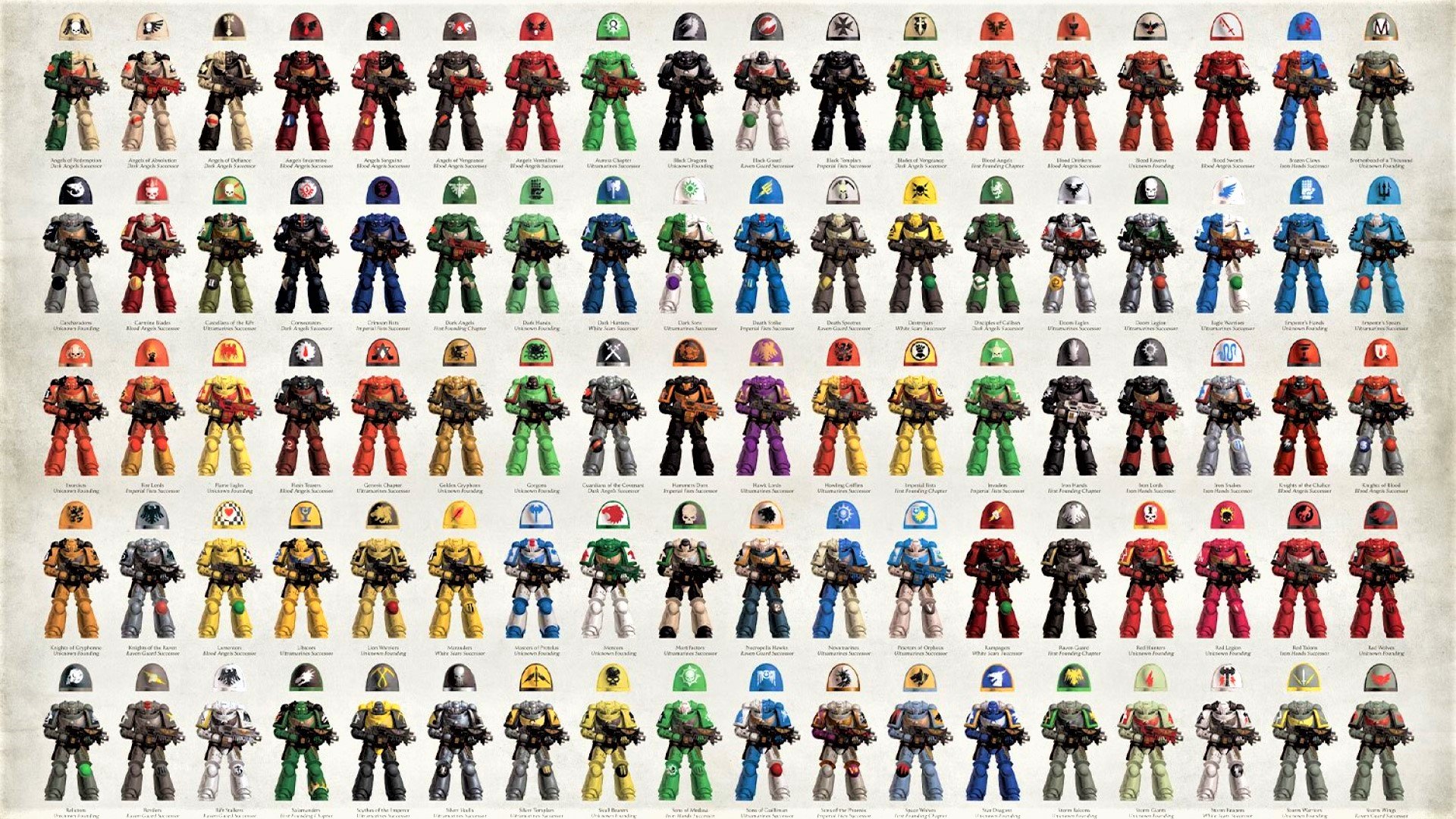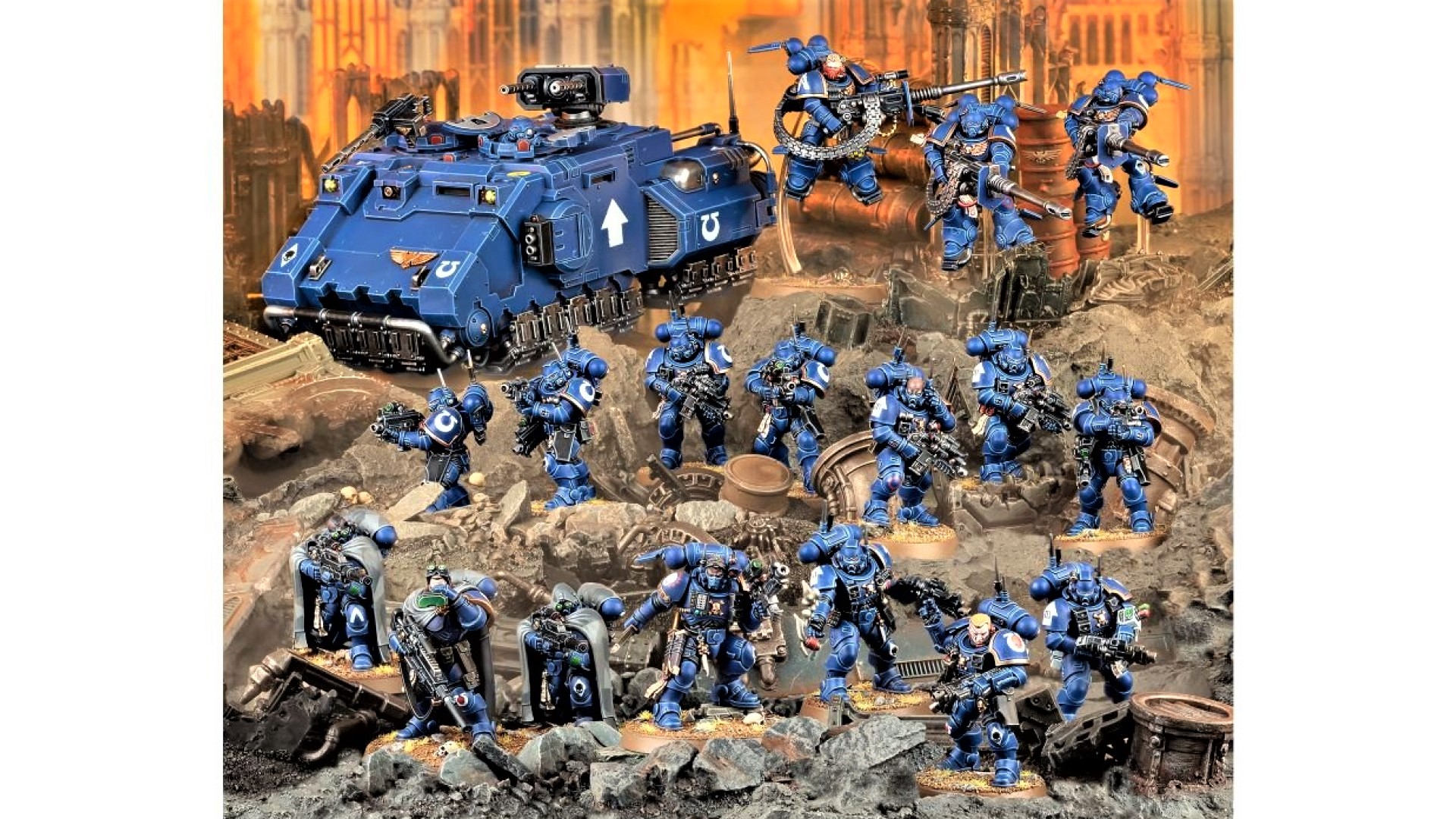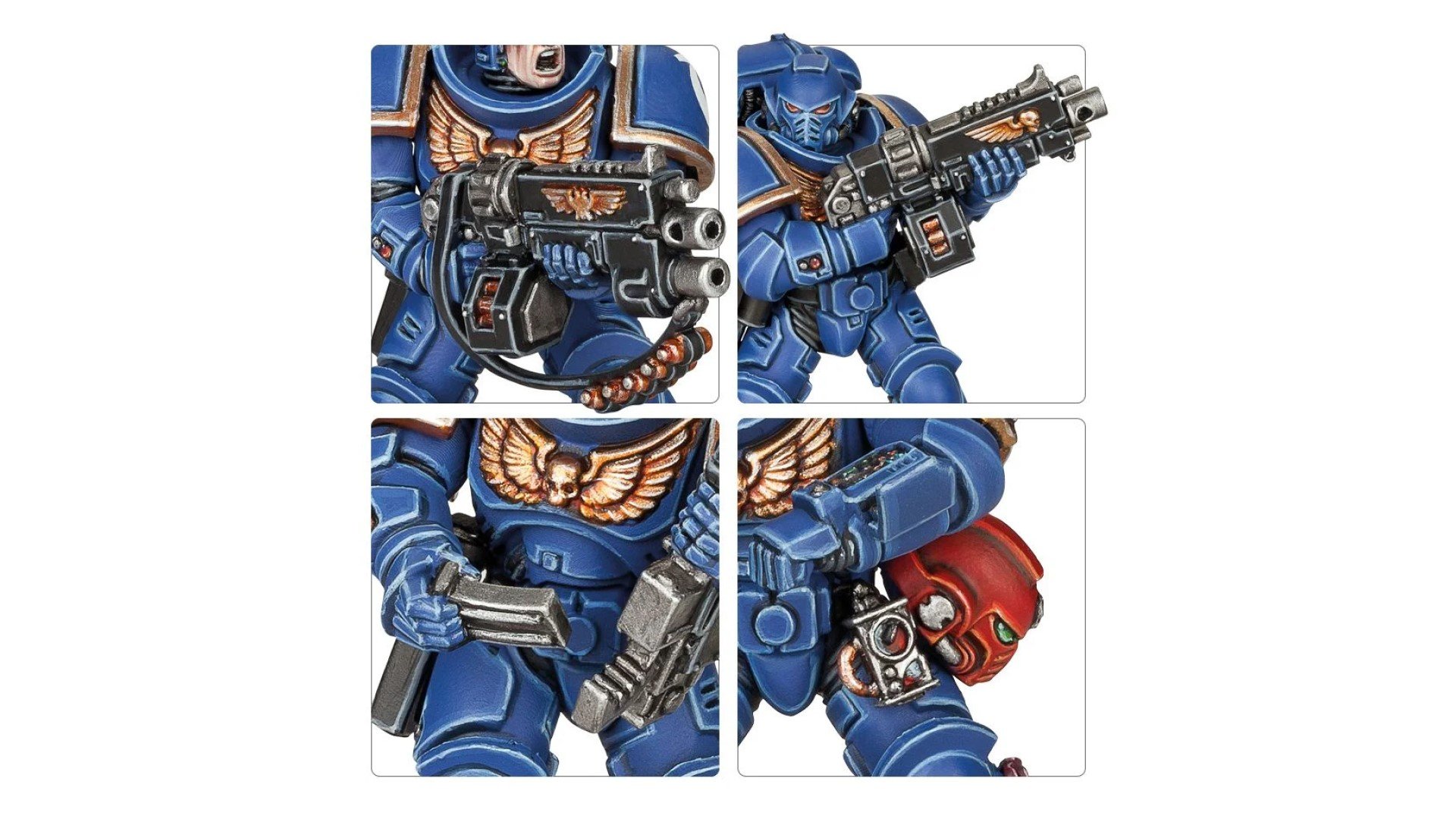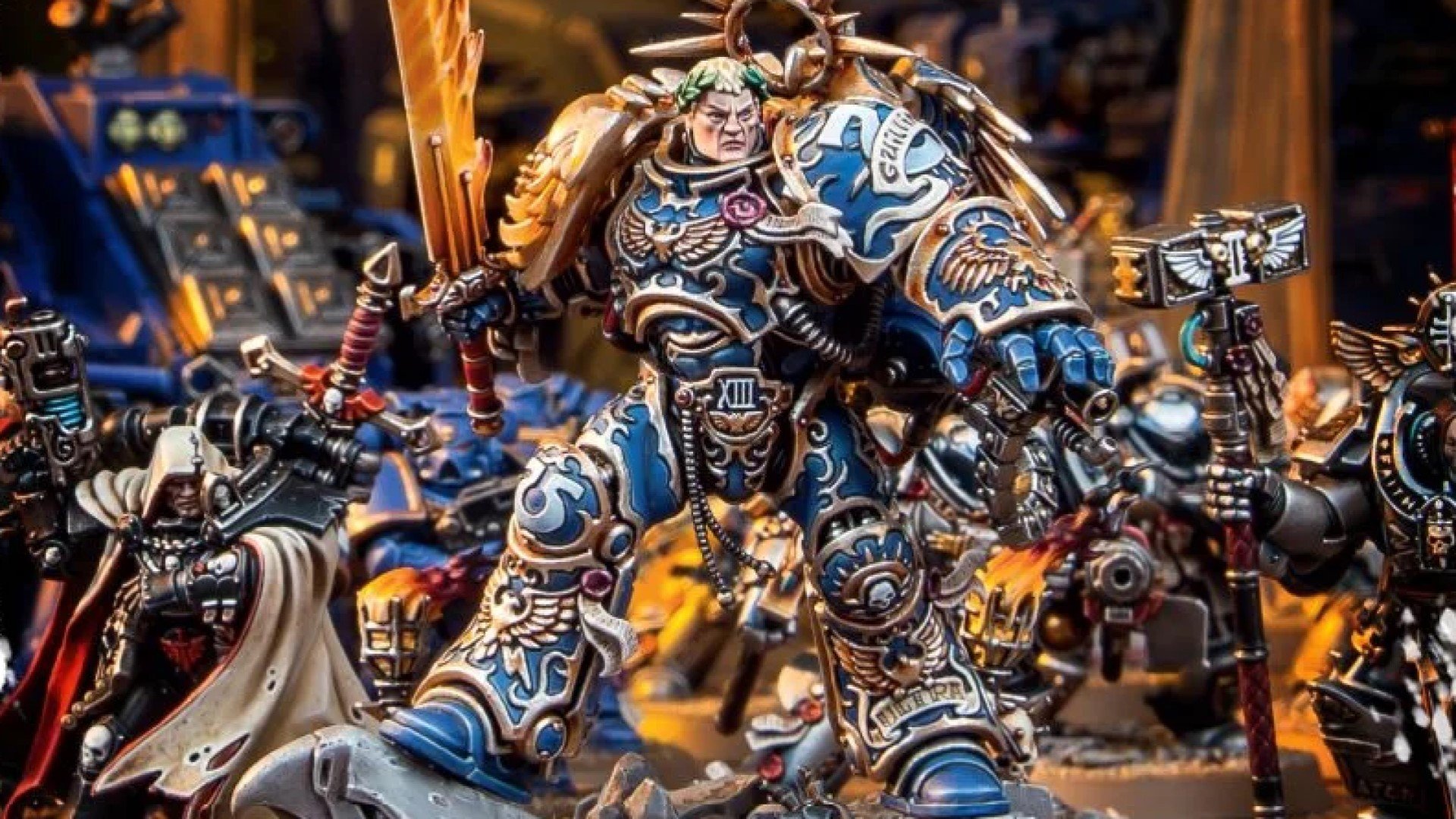Warhammer 40k’s Space Marines are undoubtedly the veteran sci-fi wargame’s most famous, popular, and prominent army. Arguably Games Workshop’s most successful creation, the power-armoured super-soldiers of the Adeptus Astartes are Warhammer 40k’s best known characters – and a perpetual favourite tabletop army, with an eye-watering range of miniatures. Here’s our comprehensive guide to the Space Marines lore and gameplay – from their Horus Heresy roots to the current, Primaris era.
Mighty defenders of the Imperium of Man, Warhammer 40k Space Marines have been the public face (or rather faceplate) of GW’s sci-fi wargame almost since its inception in 1987. More than the other Warhammer 40k factions, Space Marines still play a starring role in the game – from the vast, lore-rich Horus Heresy book series, right through to Angels of Death, an animated TV show on GW’s new Warhammer+ subscription service.
In Warhammer 40k 9th Edition, after 30 years of development, the Space Marines are a huge, varied, and versatile army, with nearly 100 different units listed in their Warhammer 40k codex rulebook – all organised into distinctive, colourful chapters with their own rules and ways to play. Space Marines are a fantastic way into the Warhammer 40k hobby, and we’ll explain everything you need to know about them.
Space Marine legions
In 40k lore, the Space Marine legions were the first organised armies of Adeptus Astartes warriors – formed and blooded in the 31st millennium – ten millennia before the setting’s ‘present day’.
Intending to breed an army with which to reconquer humanity’s lost holdings across the galaxy in a Great Crusade, the Emperor of Mankind created 20 vast legions of transhuman marines – the Legiones Astartes – using a combination of his own genius, and the work of many genetic scientists (chief among them Amar Astarte, after whom the resulting warriors were named).
Each legion was many thousands strong, and each bred exclusively from the genetic material of one of the Imperium’s extraordinary Primarchs: uniquely advanced primogenitor marines made from the Emperor’s own ‘geneseed’, each of whom would act as a crusading general at the head of his allotted legion.
The Primarchs and their legions fought alongside one another for many years in the Great Crusade, successfully expanding the Imperium far and wide throughout our galaxy – latterly under the leadership of Horus Lupercal, Primarch of the XVI Legion, named ‘Warmaster’ by the Emperor himself.
Then, tragically, nefarious Warhammer 40k Chaos forces intervened. Several times.
Thanks largely to the cunningly laid schemes of Erebus, of the Word Bearers legion, Horus Lupercal was turned to the service of the Chaos gods, and launched a civil war against the Emperor’s rule (later known as the Horus Heresy).
From the Heresy’s initial, devastating ambushes at Istvaan III and V -and for all time thereafter – the 18 Space Marine legions were to be split by Imperial historians into two camps: they were loyalists, or they were traitors.
We’re going to give you a bit of a spoiler here: the loyalists won. The Emperor killed Horus aboard the Warmaster’s attacking flagship, the Vengeful Spirit; the traitor forces splintered and fled; and the loyalists chased the routed remainders of the invading fleet right into the dreaded Eye of Terror. If you want to know what happened to them, read our guide to Warhammer 40k’s Chaos Space Marines.
And, as of 2022, with Games Workshop re-launching the Warhammer: The Horus Heresy tabletop wargame with the massive Age of Darkness box set, you can now collect and lead your own Heresy-era Space Marine legions.
For now, though, we’re interested in what happened next for the Space Marines who remained loyal to the Imperium of Man.
Space Marine chapters
Shortly after the Horus Heresy ended – with the traitor Warmaster’s death, and the enshrinement of the mortally wounded Emperor upon the Golden Throne – Ultramarines Primarch Roboute Guilliman reformed the Space Marine Legions into a host of much smaller Space Marine Chapters, intending to ensure that never again could such a vast force of Adeptus Astartes turn, as one, against the Imperium.
In a decree titled the Codex Astartes, Guilliman ordered that the legions be reformed into Chapters with a maximum of 1000 Space Marines in each, and prescribed codes of combat to guide them. This event, called the Second Founding, created a whole range of brand new ‘Successor’ Chapters, split off from their parent legions, with their own leaders, livery, and insignia.
Now, 10,000 years later, in the 41st millennium, there are thousands of Space Marine chapters active across the galaxy, but among the mightiest remain the so-called ‘First Founding’ chapters – formed from the original Legiones Astartes who stayed loyal.
Some follow Guilliman’s edicts in the Codex Astartes all these millennia later – others, not so much – and all but the lucky Ultramarines are now missing their Primarchs, as every single one, except Roboute Guilliman, is either dead or lost in action. As for the tabletop, each of them got their own Codex Supplement in 8th Edition; in 9th Edition, only a couple have got a new one so far. Let’s meet them.
Dark Angels
The former I Legion Astartes, the stern, secretive Dark Angels hail from the forest planet of Caliban. Or rather, the remains of the planet Caliban – the world itself was destroyed, but the Dark Angels chapter still sails the void in a huge spacecraft built from a fragment of the dead planet, which they call The Rock.
During the Horus Heresy, a large portion of the Dark Angels legion turned to Chaos, leading to a huge, ultraviolent confrontation that saw the loyalist side victorious (but decimated), the planet Caliban itself shattered to bits, and the surviving traitor Dark Angels scattered out into the galaxy, forever to be known as ‘the Fallen’ by the loyalists, who would hunt them down for eternity, in search of absolution for their Chapter. In the 41st millennium, as a Codex compliant chapter, the Dark Angels are still on this mission of redemption, with multiple successor chapters aiding them.
In battle, the Dark Angels are all about coordinated strikes from specialised ‘wings’, each used to maximum effect. Ravenwing bikers, land speeders, and flyers harry the foe with fast-moving cavalry charges, while a core of ranged infantry fire off fusillades of plasma fire from drilled battle lines. Then, once enemy lines are weak, the terminator-armoured Deathwing knights crash in to finish them off. Dark Angels take some balance to play, but they can be devastating.
If you want to learn more about them, dive into our full Warhammer 40k Dark Angels guide.
White Scars
The White Scars – formerly the V Legion Astartes – are renowned as both one of the most popular Space Marine chapters, and one of the hardest to paint. The sons of Primarch Jaghatai Khan, a.k.a. the Warhawk, the White Scars were briefly neutral in the Horus Heresy, before coming down firmly on the side of the Emperor. In the 41st millennium, they’re still going strong, and compliant with the Codex Astartes, counting many successor chapters to their name.
Now, there’s no beating around the bush on this one: these folks are an incredibly on-the-nose sci-fi analogue for the mounted Mongol hordes of Genghis Khan, which conquered most of the (real) world in the 12th century. The language, names, cultural mores, and martial traditions of their home planet, Chogoris – and all who hail from there – are strongly coded around real-world East Asian and Steppe cultures.
While these themes are sometimes used to create exciting fiction and super-cool in-game content, they’re not too subtle, or particularly diligently tied to any real history. Your mileage with this may vary – but it’s something to be aware of.

In battle, the White Scars are all about speed and tactical agility, with rules and abilities that favour swift assaults and sly manoeuvring tricks to outfox enemy defences.
White Scars armies therefore tend to include a lot of bikes, land speeders, and other fast vehicles, as well as troop transports, to get their whole fighting force into the position in record time.
Space Wolves
Once the VI Legion Astartes, the lupine sons of Leman Russ – also known as the Emperor’s Executioners, among many, many other names – the Space Wolves command just as much respect and fear in the 41st millennium as they did in the 31st.
Ferocious, instinctive fighters, they channel the spirit of their fearsome, furry namesakes by fighting in packs, and favouring vicious, overwhelming melee combat over big guns, or fancy footwork. It’s worth noting, too, that, in terms of cultural analogues, these guys are to Scandinavia as the White Scars are to Mongolia. Cold weather, Futhark runes, and plaited beards aplenty.
While they are as fiercely loyal to the Emperor as ever, the Space Wolves absolutely do not adhere to Roboute Guilliman’s Codex Astartes. We don’t know exactly how many Space Wolves Space Marines there are in the 41st millennium, but it’s significantly more than 1000.
And, far from organising marines into ten companies of ten separate ten-marine squads, Space Wolves go to war in Great Companies, made up of many dozens of Wolf Packs, organised by battlefield role and seniority (or a mixture of the two). In short, they do things their own way, to the max.
On the tabletop, this goes double; the Space Wolves have long had custom in-game rules that reflect just how different they are from your standard Space Marine.
A variety of unique, sharp-fanged units, such as Thunderwolf Cavalry, Fenrisian Wolves, and the terrifying Wulfen, combine with powerful close combat buffs and stratagems, to make Space Wolves one of Warhammer 40k’s most powerful melee armies.
Imperial Fists
Originally the VII Legion, led by Primarch Rogal Dorn, the Imperial Fists are mostly famed for two things: their vivid yellow armour, and their prodigious skill at fortification and defence.
Put in charge of the protection of Terra (Earth) and its solar system during the Horus Heresy, the Imperial Fists and their Primarch won many great victories against Horus’ forces in the extended Siege of Terra, and were certainly vital to the loyalists’ survival under the onslaught of Chaos. Now, 10,000 years later, the Imperial Fists still share the reserved, sceptical, and stoic disposition of their blond-haired gene-father.
They follow the Codex Astartes – with a couple of dozen Successor Chapters to their name – and are based partly on Holy Terra, and partly aboard the Phalanx, Rogal Dorn’s enormous flagship-slash-fortress monastery.

The Fists also retain their historic expertise where fortifications are concerned, boasting a variety of stratagems and custom psychic powers centred around tackling enemies in buildings, and a Chapter Tactic that lets them ignore enemies’ Light Cover when shooting at them – representing the Fists’ unmatched talent at spotting weak points in walls.
The stolid Imperial Fists may not be the most ‘rock n’ roll’ of Space Marine Chapters; nor, usually, are they the most competitively powerful – but their august history and striking colour scheme makes them a favourite of many.
Blood Angels
Formed from the IX Legion Astartes, the Blood Angels are the gene-sons of the handsome, tragically clairvoyant Primarch Sanguinius, who was killed by his brother Horus Lupercal in the final battle of the Horus Heresy. They are led, in the 41st millennium, by Commander Dante, the oldest living Space Marine.
These scarlet-armoured paragons are rightly celebrated as one of the Adeptus Astartes’ most devastating aerial assault forces, and deadly, elegant close-quarters fighters – with a notable streak of altruism and protectiveness over the Imperium’s human citizens that’s often absent in other Space Marine Chapters. But, while nobility and heroism flow through the proud Blood Angels’ veins, so too does their hidden Flaw, a disastrous fault in Sanguinius’ genetic code that lurks within every single Space Marine of the Blood Angels and their Successor Chapters.

The Flaw can manifest in two ways:
The Black Rage: An agonising psychic echo of Sanguinius’ death at Horus’ hands is imprinted into the mind of every Space Marine of his geneseed. At any time – but usually in the midst of battle – this shared genetic memory can overtake them, filling them with all the vengeful fury felt by the Primarch at the moment of his death, and driving the Space Marine’s lesser mind completely insane.
Blood Angels taken over by the Rage are assigned to the Chapter’s infamous Death Company, and deployed where the fighting is thickest, to slake their insatiable anger with the deaths of enemies, before meeting their own end.
The Red Thirst: Buried deep in every Blood Angel’s genetic coding is an instinctive call to violence and bloodshed, which, if embraced and followed to the fullest, leads to an obsession with, and thirst for, the lifeblood of enemies. While the specific effects of the Red Thirst are the Chapter’s most shameful, and best kept secrets – rumours abound that its victims effectively become the vampires of legend, with sharp fangs, pale skin, extended lifespans, and a compulsion to drink living blood.
Still, if you can get over their potentially haemovorous tendencies, the Blood Angels are an ancient, storied, and distinctive Chapter to collect and play on the tabletop, with quite a few unique units to their name, such as the Death Company and Sanguinary Guard.
The Chapter’s latest dedicated rulebook, the 9th Edition Blood Angels Codex Supplement, came out on December 5, 2020.
Iron Hands
Formerly known as the X Legion Astartes, the Iron Hands Chapter have a closer affinity with the technology-loving machine cult of the Adeptus Mechanicus than any other Space Marine Chapter, or perhaps any other branch of the Imperium. In battle, they’re renowned for fielding large numbers of tanks, Dreadnoughts, and other war machines, as opposed to massed infantry – and for encouraging augmetic body part replacements (or improvements, depending on your point of view) among their Space Marines.
This tendency towards mechanised warfare and cyborg enhancements is partly an expression of the personality of their dead Primarch, Ferrus Manus, the consummate engineer, who was decapitated by the traitor Primarch Fulgrim in the opening acts of the Horus Heresy.
But it’s also an attempt to ‘engineer out’ their human emotions, to purge their grief and guilt for Ferrus Manus’ death – as well as, originally, a straightforward practical measure to compensate for their miniscule numbers of marines, the Chapter having been gutted and routed in the infamous Istvaan V Drop Site Massacre.
Iron Hands were, for a brief period during Warhammer 40k’s 8th Edition, an incredibly dominant army in the game’s tournament scene, due to a combination of rules that made all their units unusually survivable, while their vehicles kicked out devastating damage. This was balanced out with a rules FAQ in October 2019, however.
Ultramarines
Of all the Space Marine Chapters, the Ultramarines probably need the least introduction. The ‘standard’, vanilla flavour of Space Marines, these disciplined, martial, Ancient Rome-inspired sons of Primarch Roboute Guilliman are the ultimate poster boys – both for of the Imperium of Man, and for Warhammer 40k itself, appearing on every box and every poster.
Starting life as the XIII Legion Astartes, the Ultramarines At the time of the Horus Heresy, the Ultramarines were by far the largest Space Marine legion, numbering in the tens of thousands. Though they sustained heavy losses – including through the catastrophic surprise attack at Calth by the traitorous Word Bearers – it remained a massive fighting force throughout the Heresy, and spawned no fewer than 18 Successor Chapters when the Codex Astartes took effect.

In the 41st millennium, the Ultramarines (and their dozens of Successor Chapters) form the core of the resurrected Primarch Roboute Guilliman’s efforts to restore and revitalise the Imperium.
They’ve played a prominent part in the game’s main storyline of late, as Guilliman fought off an attack on his own realm of Ultramar by Mortarion’s Death Guard (read Guy Haley’s excellent Dark Imperium trilogy for more)
If you want to don that shining azure armour and join the Imperium’s pre-eminent Space Marines chapter, best get clued up with our Warhammer 40k Ultramarines guide.
Salamanders
The XVIII Legion Astartes, and a proud and resilient First Founding Chapter, the green-armoured Salamanders are a rather distinctive lot, for a few different reasons.
Native to the volcano-covered Death World of Nocturne, and based in a fortress monastery on its moon, Prometheus, the Salamanders favour fire, and flamer type weapons, above all other Chapters – as evidenced on the tabletop by their unique Flamecraft and The Fires of Battle stratagems.
In Warhammer 40k lore, the Salamanders, like their lost Primarch, Vulkan, are also uniquely concerned with the welfare of the Imperium’s human citizenry, capable of stubbornly refusing to cooperate with a battle plan if it involves severe collateral damage to civilian populations.

In another questionable analogue to real-world human ethnicities, the Salamanders are also notable for their stone-hard, obsidian-black skin. Canonically, it’s caused by one of the Space Marines’ implanted extra organs, the Melanochrome, which causes their skin to change its colour and structure to protect against radiation-rich environments, in the same way humans’ skin evolved over millennia to be darker-coloured in sunnier climates – only orders of magnitude faster.
They’re pointedly not officially related to Earth’s black-skinned African ethnicities in any way – and yet, mysteriously, many Salamander characters in GW’s Black Library audiobooks are voiced with recognisable, yet non-specific African accents. More than anything, the Salamanders’ lore and real-world connections just seem disappointingly confused, and feel like a missed opportunity for Black African representation.
Like various aspects of Warhammer 40k lore, this topic has sparked many unpleasant, and often very stupid, debates among fans. The bottom line is that the Salamanders make sense in-universe, but – like the White Scars, Space Wolves, and Sisters of Battle, among others – they’re evidence that Warhammer’s narrative roots were planted in a time when haphazard, ill-considered fictional representations of women and people of colour were commonplace. It’s not a reason to cancel them, just important context – and a valuable reminder of Warhammer’s golden rule: don’t be a dick.
Once you’ve squared that away, there’s loads to love about this army. With, a Chapter Tactic and special rules themed around reliable, high-quality weaponry, they tend to be one of the more competitive Space Marine armies, too. Oh, and Vulkan lives!
Raven Guard
The XIX Legion Astartes, now the Raven Guard Chapter, hold the triple distinctions of being the most ’emo’ Space Marine Chapter; the stealthiest Space Marines; and the ones with the silliest names.
Their Primarch’s name, Corvus Corax, is literally the real-world Latin species designation for the common raven (and, individually, both those Latin words also mean ‘raven’). His chapter’s fortress monastery, on their homeworld of Deliverance, is called the Ravenspire. It’s serious overkill.
Still, with that out of the way, these alabaster-skinned, jet-black-haired Space Marines have a noble history of service to the Imperium – cruelly interrupted, like that of the Iron Hands and Salamanders, by being very nearly exterminated in the Istvaan V massacre.
The Raven Guard survived, however, and thrived, cultivating a name for themselves as silent, efficient killers, adept at achieving perfect positioning, before descending upon the foe from above to deal out sudden, sharp-bladed death. Codex Compliant, the Raven Guard boast a respectable family of Successor Chapters, including – most likely – the well-loved, shark-fancying Carcharodons Chapter.

In the 41st millennium, the Raven Guard are led by Chapter Master Kayvaan Shrike, who recently crossed the Rubicon Primaris, changing from a Firstborn marine into a Primaris Space Marine, and getting a gloriously moody new miniature in the process.
Space Marines successor chapters
In Warhammer 40k lore, there are many hundreds of known Space Marine successor chapters, so we couldn’t possibly cover them all – but there are a handful which have carved out more of a name for themselves than most – so we’ll tell you a little bit about those trailblazers.
What’s more, there are a number of Space Marine armies that stand apart from the main chapter structure – if you’re interested in the silver-armoured, psychic, daemon-hunting Knights of Titan, check out our full guide to Warhammer 40k Grey Knights.
If you lean more towards black-clad, alien-busting special ops Kill Teams, you’ll want to peruse our Warhammer 40k Deathwatch guide.
And if (like famous 40k fan Henry Cavill) you feel drawn toward the golden light and preternatural fighting skills of the Emperor’s chosen bodyguards – check out our guide to the Adeptus Custodes.
In the meantime, though, let’s meet the:
Black Templars
By far the largest and most storied Successor Chapter out there, the zealous, crusading Black Templars, more than any other Space Marine Chapter, the angry, vengeful, hate-fueled, religious fury at the heart of the Imperium of Man in the 41st millennium.
Though they were founded from the dour, reserved Imperial Fists, and are created from the very same geneseed – that of Rogal Dorn – the Templars personify that noble Primarch’s permanently subdued rage, unleashed, and focused through the refining prism of dogmatic belief in the Emperor’s divinity, to produce an unrivalled destructive force, powered by faith and fury.

The Black Templars don’t even come close to following the Codex Astartes, recruiting new Space Marines as widely as possible, and conducting vast, endless, thousands-strong crusades against the Imperium’s many enemies in all kinds of far-flung corners of the galaxy.
We’ll have a fully-fledged guide on the Black Templars soon, but for now, check out our coverage of the 2021 Black Templars army set, featuring a new Black Templars codex, and a bunch of brand new models for the Chapter.
Crimson Fists
If the Crimson Fists Space Marines were a word, that word would be: ‘indomitable’. A less kind word might be ‘inflexible’.
Another Successor Chapter of Rogal Dorn’s Imperial Fists, their entire forces, fortress monastery, and home planet of Rynn’s World were almost entirely wiped out by an Ork Waaagh! from which they refused to retreat – but the Chapter survived, by skin of its teeth, and by the legendary, unstinting courage of their Chapter Master Pedro Kantor, with just a few Space Marines left.
Since then, despite their minimal numbers, and the devastation of their home region of space, the Crimson Fists have dutifully followed the Codex Astartes, and built a martial reputation around their knack for stubbornly holding ground. Even their tabletop Chapter Tactic reflects it: appropriately titled No Matter The Odds, it grants Crimson Fists models a bonus to hit, if they’re shooting at a unit with at least five more models in it than the shooter’s own. Worth choosing if you like to make a stand.
Flesh Tearers
The Blood Angels’ most famous Successor Chapter, the Flesh Tearers, have a well deserved reputation for ferocious bloodlust (the clue’s in the name). Shunned by their parent Chapter and the other Successors for their uncommon, occasionally uncontrolled brutality in battle, the Flesh Tearers have come close to being excommunicated from the Imperium and designated Renegades, but have always been exonerated as loyal – though just barely.
With their strain of their Primarch’s geneseed especially prone to Sanguinius’ genetic faults, more Flesh Tearers succumb to the Black Rage and Red Thirst than any other Blood Angels Successors – adding to their reputation for unchained slaughter, and suspicions of Chaos corruption.
Their Chapter Master, Gabriel Seth (that’s his yearbook photo above) mitigates the worst of this by committing his troops as vanguard forces right into the thick of every assault, hoping to sate their desire for bloodletting, and minimise chances of the Flesh Tearers losing control and tearing into their own allies.
The arrival of Primaris Space Marine reinforcements has also reportedly been a stabilising influence, as they appear more resilient to the pitfalls of Sanguinius’ infamous genetic ‘Flaw’.
Primaris Space Marines
The Primaris Space Marines are the pinnacle of transhuman soldiery, a more physically advanced, better equipped, upgraded version of the Space Marines, engineered over ten millennia by Archmagos Dominus Belisarius Cawl – an ingenious, eccentric, and decidedly dangerous senior Tech-priest of the Adeptus Mechanicus.
Introduced to the tabletop game and the fiction at the same time, with the launch of Warhammer 40k’s 8th Edition in 2017, the Primaris Space Marines started off with a small selection of up-scaled Space Marine characters and units – but, in 2021, they represent an entire new model range of their own.
Taller, stronger, and faster than the original ‘Firstborn’ Adeptus Astartes, clad in upgraded Mark X power armour, and equipped with a whole range of superior wargear, the Primaris marines do all the same things as their forebears – only better.
On the tabletop, this difference is minor – the Primaris merely get one extra attack in close combat – but, in Warhammer 40k lore, the gulf between the Primaris and Firstborn is colossal, and significant.

Almost all the Space Marine Chapters have now had large influxes of Primaris Space Marine reinforcements delivered by elements of Roboute Guilliman’s Indomitus Crusade – and, where Primaris and Firstborn have suddenly begun to fight together, friction, distrust, and culture shock have resulted.
Entire new Space Marine Chapters, such as the Fulminators and Rift Stalkers, have been formed entirely of Primaris marines, in the so-called Ultima Founding, ordered by Roboute Guilliman.
Even prominent leaders among the Firstborn Space Marines have undergone arcane and painful surgery to be converted into Primaris marines – led by Ultramarines Chapter Master Marneus Calgar, and followed by many others, including the Black Templars’ High Marshal Helbrecht.
The burning question – both on the tabletop, and canonically in Warhammer 40k lore – is: are the Firstborn marines on the way out? Will the new and improved Primaris breed entirely replace the original Adeptus Astartes that have held firm in defence of the Imperium of Man for 10,000 years? Only time will tell.
Prominent Primaris Space Marine units include:
- Intercessors (and Assault, Heavy, and Veteran variants)
- Hellblasters
- Inceptors
- Aggressors
- Eradicators
- Bladeguard Veterans
- Outriders
- Redemptor Dreadnoughts
Vanguard Space Marines
The Vanguard Space Marines, introduced to both the tabletop game and Warhammer 40k lore in the 2019 Shadowspear box set, are a specialised sub-set of the Primaris Space Marines, kitted out for covert operations, stealth, sabotage, and reconnaissance.
Vanguard Space Marines wear a modified version of the standard Primaris Mark X power armour, designated ‘Phobos’ pattern, which does not alter their in-game defensive stats, but does make them eligible for certain stratagems and psychic powers.
Probably the most popular Vanguard Space Marine units have been the Infiltrators and Incursors – alternative Troops choices to the vanilla Primaris Intercessors, which each offer their own added tactical advantages.

Both units can deploy anywhere on the board more than 9″ from enemy units; the Infiltrators have an aura that blocks enemy Deep Strikes, and can use a 5-point upgrade to benefit from your HQs’ aura buffs wherever they are; while the cheaper Incursors have boltguns that ignore cover, and can place anti-vehicle Haywire Mines.
Prominent Vanguard Space Marine units include:
- Infiltrators
- Incursors
- Reivers
- Suppressors
- Eliminators
Female Space Marines
So, why aren’t there any female Space Marines? As you might imagine, it is a vexed question.
Women can join the Astra Militarum, a.k.a. Imperial Guard; women fight the enemies of the Imperium as Sisters of Battle; women have equal status in the Adeptus Mechanicus; and women have always served at all ranks in the Imperial Navy, as well as every level of the civilian government, in all corners of the galaxy-spanning empire of humanity. So why are there no women in the Emperor’s most elite fighting forces?
The commonly heard in-universe answer (usually made up on the spot by sexually insecure male Warhammer fans, for whom the existence of powerful, dominant, and especially combatant female characters in any fiction is inexplicably enraging) normally involves a lot of waffle about how the Emperor’s gene-crafting processes ‘just weren’t designed’ for female bodies. As if it made any kind of sense for the nigh-omnipotent Emperor of Mankind to rule out half his subject human population as potential recruits.
The short, real world answer is that game-makers shape their protagonists (and make no mistake, the Space Marines are the closest thing Warhammer 40k has to protagonists) to fit the aspirational, power-fantasy self-image of their core customer base; and, when GW created Warhammer 40k in the late 80s and early 90s, that core customer base was almost exclusively men and boys.
Let’s be clear, the reason there aren’t Fem Space Marines now has nothing to do with “lore”. The models were sculpted and sold by GW but didn’t sell well enough in a male dominated niche sci-fi hobby in the 80s/early 90s. Lore added later. It was a business decision. That’s all. pic.twitter.com/GaTOuHBTXU
— Mikes40k (@mikes40k) October 1, 2020
According to widely shared Facebook posts attributed to former head of GW Intellectual Property Alan Merrett, the firm did make a few female Space Marine figures in the runup to Rogue Trader, Warhammer 40k’s first edition – but they sold poorly, and simply got dumped for that reason.
As Merrett says in one of the posts: “all the background fluff about why there are only male Marines is there to justify a commercial logistics issue”. That pretty much sums it up.
Will we get female Space Marines eventually? Hopefully; it would add some much needed variety and representation in Warhammer’s most famous faction.
And GW has already taken one step towards it, by including women in the Stormcast Eternals, the Space Marines’ direct analogues in fantasy game Warhammer Age of Sigmar. So, here’s hoping.
Space Marine game
Warhammer 40,000: Space Marine, released in 2011 by developer THQ, from developer Relic Entertainment, is very possibly the best Warhammer 40k game ever made, for PC or games consoles.
It’s a videogame that focuses almost all its energy on the audiovisual rhythm and sheer serotonin-pumping, kinetic joy of its combat gameplay – and fills in the piffling details of story, characters, environments, level design, and other such distractions, afterwards.
Stepping into the ceramite boots of Ultramarines Captain Titus, you’ll lead your squad through the Ork-infested factories and streets of an embattled Adeptus Mechanicus Forge World, and along the way uncover a nefarious Warp plot hatched by a Chaos Space Marine sorcerer.
Frankly, though, most of that matters little – because what this game is about is living the weighty, muscular, metallic power fantasy of being a Space Marine. It’s like Gears of War, but with less forced, overcompensating masculinity and feigned emotion, and more guiltless, fluid, transhuman ultraviolence in the Emperor’s name. It’s unsettling, but oh so brilliant.
If you haven’t played it, why not? You’ve had a decade! Go and play it after reading this. There’s even a brand new Anniversary Edition now, rolling in all the DLC packs and a bunch of extras – so you really have no excuse.
Space Marine 2
What’s more, there’s now a sequel on the way! Check out our running guide to keep up-to-date with the Space Marine 2 release date, as well as the latest news and trailers for the game.
Space Marines codex
The current 9th Edition Warhammer 40k Space Marines codex was released on October 10, 2020 – you can order it now from the Games Workshop webstore.
Overall, the 9th Edition Space Marine codex has generally received a positive, if not jubilant, response from the Warhammer 40k community – as it’s widely thought of more as a translation of their second 8th Edition codex to fit the new 9th Edition rules, than a serious shake-up of the faction as a whole.
Along with datasheets for the new units included in 9th Edition’s Indomitus launch box set, and a raft of smaller changes, one of the most prominent new additions was the new Chapter Command ruleset, which allows you to upgrade certain Space Marine characters (such as Chaplains, Apothecaries, and Librarians) to more senior versions, with access to new, and sometimes very powerful, abilities.
We don’t yet know whether Space Marines will receive a second, updated codex in 9th Edition, as they did in the latter half of 8th Edition. For now, the faction is neither struggling, nor dominant in the competitive scene; just doing fine – which is normally a good gauge of whether GW is likely to cook up a new rulebook. So it seems likely the current Space Marines codex is here to stay, for a while at least.
Space Marines tactics
Space Marines tactics, as a phrase, covers a massive diversity of topics – since the multifarious Space Marine chapters enjoy differing levels of customised tabletop rules, reflecting their drastically different ways of making war in the ‘fluff’ (meaning the lore and fiction of Warhammer 40k).
Where an Ultramarines force will do its best work through coordinated fire and manoeuvre, flexible tactics, and volley fire, the Iron Hands might prefer tanks and heavy weapons – while Black Templars tend to eschew most tactical traipsing about, in favour of all-out furious assaults.
We meant it when we said there were a lot of ways to play Space Marines – and we’ll go deeper into Chapter Tactics, psychic abilities, Warlord Traits, Relics, and the all-important Stratagems, in later updates – but for now, here’s a basic-level view on how Space Marine armies work in 9th Edition.

Warhammer 40k rules have always faced a challenge in faithfully representing the canonically overwhelming offensive powers of Space Marines, while keeping them as a balanced army within the game’s meta.
Currently, this is achieved using a cluster of in-built rules for (almost) all Space Marines, called:
- Combat Doctrines
- Bolter Discipline
- And They Shall Know No Fear
- Armour of Contempt (added in June 2022)
Don’t worry, we’ll make ’em clear as mud.
Combat Doctrines
The Combat Doctrines rule grants Space Marines bonuses to their armour piercing (AP) stat on different weapon types, depending on how far you are through the battle. The three doctrines automatically cycle from one to the next, with each new Battle Round, as follows:
| Battle Round | Combat Doctrine | Effect |
| 1 | Devastator Doctrine | +1 AP for Heavy and Grenade weapons |
| 2 | Tactical Doctrine | +1 AP for Rapid Fire and Assault weapons |
| 3 | Assault Doctrine | +1 AP for Pistol and Melee weapons |
| 4 | Assault Doctrine | +1 AP for Pistol and Melee weapons |
| 5 | Assault Doctrine | +1 AP for Pistol and Melee weapons |
Essentially, it rewards you for following a balanced, step-by-step battle plan: Fire the big guns at range in your first turn; move forward and shoot with your main troops in turn two; and charge in for a close-up scrap in turn three. For some Chapters, like the Ultramarines, it’s perfect; for others, less so – but there are Stratagems to get around that, by temporarily changing the active Doctrine. A Space Marine always has options.
Bolter Discipline
Dead simple, this one: when shooting ‘Rapid Fire’ weapons, you normally get to fire twice the normal amount of shots if your target is within half the weapon’s maximum range.
But, since Space Marines are really good at shooting their Bolt weapons, they will also get double shots with those guns if:
- they’re an Infantry unit and they didn’t move this turn
- they’re a Terminator or Biker
It means that, whether you’re playing a static, defensive force of Marines in cover firing Bolt Rifle volleys, or a super-fast shock force of Bikers, you’ll put out more shots, more of the time, over longer ranges than a lot of other armies. Plus, even if you’ve moved an Infantry unit, you can use the 2CP Stratagem Steady Advance to make it as if they hadn’t moved, and still benefit from the double shots.
And They Shall Know No Fear
Space Marines literally have the neurological mechanisms for fear bred out of them – their ‘fight or flight’ has been completely reprogrammed until it’s more like ‘fight or do nothing’.
As a result, Space Marines get to ignore all modifiers to their Combat Attrition tests – meaning that, when they take losses in battle, the chances of them running away are a) low, and b) not affected at all by enemy units’ abilities that are supposed to damage leadership and morale.
This rule used to be a bit simpler, but the bottom line is: Space Marines hardly ever run from battle, regardless of whatever is facing them.
Armour of Contempt
In GW’s June 2022 ‘Balance Dataslate’ rules update, the Space Marines (and Imperial Guard vehicles, Grey Knights, Sisters of Battle, and Chaos Space Marines) got a powerful buff to their survivability in the form of the new Armour of Contempt rule.
Narratively, the rule represents the fact that Imperial (and ex-Imperial) power armour suits and tank plating are tough – and extra-resistant to even the armour-piercing-est of guns.
In gameplay terms, the rule is mainly intended to help these units – and especially rank-and-file Space Marines – survive for longer on tabletop battlefields now crowded with more and more high-damage, high-AP weapons that might otherwise wipe away entire elite Astartes squads with contemptuous ease.
It’s worth noting, though, that since June 2022, versions of this same rule have popped up for other armies – including the new Leagues of Votann, whose stonking Void Armour rule not only grants all their units a one-point AP debuff on incoming attacks, but also prohibits re-rolling hits and wounds against them. Woof.
When the new Space Marines codex rolls around (expect it in late 2023, one way or another) it’ll be interesting to see whether Armour of Contempt returns in a similar form, or gets swapped out for other ways to show the extraordinary resilience of holy ceramite.
Space Marine colour schemes and paints
As the photo above should demonstrate, there are essentially no limits to the best miniature paints and colour schemes to use when painting your Space Marine army. GW’s vast library of lore has fleshed out colours, insignia, and varying amounts of narrative detail for several dozen of Space Marine chapters – and if one of these catches your eye, go for it.
If it happens to be one of the pre-eminent chapters listed in the sections above, which benefit from their own custom tabletop rules, all the better – but don’t sweat it if not. Paint your models the way you want, and then, when it comes to game time, treat them as whichever chapter you like.
Unless you’re participating in some super-strict narrative event, nobody should have a problem with it – and, if they do, they’re probably not worth playing with again. This is a game, remember – it’s supposed to be fun.
There are lots of different ways to approach painting the many different potential Space Marine colour schemes – as a first step, get your teeth into our comprehensive guide to painting miniatures. YouTube tutorials by Games Workshop, and those by the Duncan Rhodes Painting Academy, can also really help you get started here. Once you’re ready to kick off, here are some standard Citadel Colour paint choices for most of the Space Marine chapters we’ve mentioned above:
| Chapter | Base Paint | Wash | Layer | Highlight |
| Dark Angels | Caliban Green | Nuln Oil | Waaagh! Flesh | Warpstone Glow |
| White Scars | Ulthuan Grey | Agrax Earthshade | Ulthuan Grey | Praxeti White |
| Space Wolves | Russ Grey | Nuln Oil | Fenrisian Grey | Blue Horror |
| Imperial Fists | Averland Sunset | Casandora Yellow | Dorn Yellow | Ushabti Bone |
| Blood Angels | Mephiston Red | Agrax Earthshade | Evil Sunz Scarlet | Wild Rider Red |
| Iron Hands | Abaddon Black | Nuln Oil | Dark Reaper | Fenrisian Grey |
| Ultramarines | Macragge Blue | Nuln Oil | Altdorf Guard Blue | Calgar Blue |
| Salamanders | Caliban Green | Agrax Earthshade | Warpstone Glow | Moot Green |
| Raven Guard | Corax Black | Nuln Oil | Eshin Grey | Dawnstone |
| Black Templars | Abaddon Black | Nuln Oil | Russ Grey | Fenrisian Grey |
| Crimson Fists | Kantor Blue | Nuln Oil | Alaitoc Blue | Hoeth Blue |
| Flesh Tearers | Khorne Red | Nuln Oil | Wazdakka Red | Cadian Fleshtone |
How to start collecting Space Marines
We’re going to make this really, really simple, because there truly are so many different paths you can take with a Space Marine army nowadays.
Step one: get yourself a Combat Patrol starter box. There are vanilla Space Marines, Space Wolves, Dark Angels, and Blood Angels variants on offer, but each contains a mixed bag of solid, versatile Primaris Space Marine units that’ll work as a starter force, and which you can happily paint up as any chapter – so pick out whichever one has the models you like best.
Step two: play with that starter army for a bit, in small games, using the rules for different Chapters in turn. Get a feel for what playstyle you most enjoy – do you like picking a strong defensive position, layering on buffs, and taking out enemies from range? Do you like quickly advancing, charging, and slashing enemies up in melee? Do you just really like Dreadnoughts? Learn what kind of Space Marine player you are.
Step three: Invest into whichever playstyle (and, if it feels right for you, an appropriate lore-accurate chapter) you found you liked best, and slowly build your army around its core strategy, adding new models that you like the look of, and which you think would play well in your list.
Space Marines are so tactically flexible, and have so many model options, that there are very few wrong answers here, and you can grow your force as slowly, or as quickly, as you like.
Love the fast movement and manoeuvrability of the White Scars for getting your marines into the fight? Pick up a couple of bikes too, to benefit from their biker stratagems. Before you know it, you’ll have twenty of them revving across the table, backed up by missile speeders, and be drinking in the imaginary exhaust fumes.
Addicted to the reliable offensives and straightforward force-multiplying abilities of the Ultramarines?
Paint up a couple more neat, shiny frontline Intercessor squads to open up new tactical options, and more pinpoint Bolt Rifle shots per turn – and it won’t be long before you’re lost in Roboute Guilliman‘s dreamy eyes and painting up the Primarch himself, to slather your forces in powerful aura buffs.
Space Marines are Warhammer 40k’s widest and deepest army, yet they remain among its most accessible, and, with a wider variety of possible paths to victory than almost any other faction, they always have the potential to surge once again to victories at Warhammer 40k’s top competitive tables.
After 30 years, they’re still the go-to army for most newcomers to Warhammer 40k, and with good reason – we can confidently recommend them as a way into the game and hobby alike. If you’re teetering on the edge of starting a Demi-Company of your own, we’d say go for it, don’t be afraid. You’re about to become one of the Emperor’s Angels of Death, after all – And They Shall Have No Fear.
Source: Wargamer



